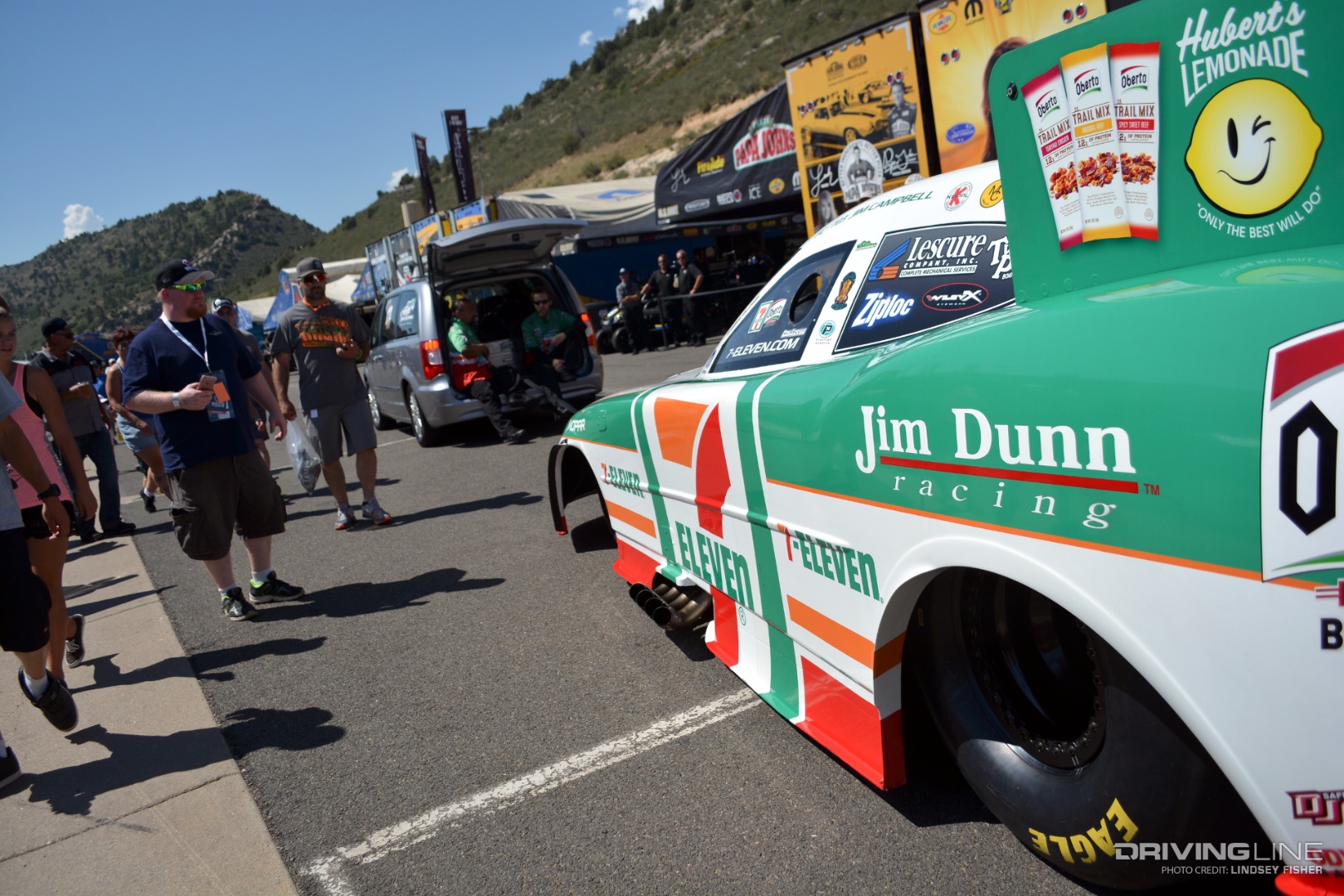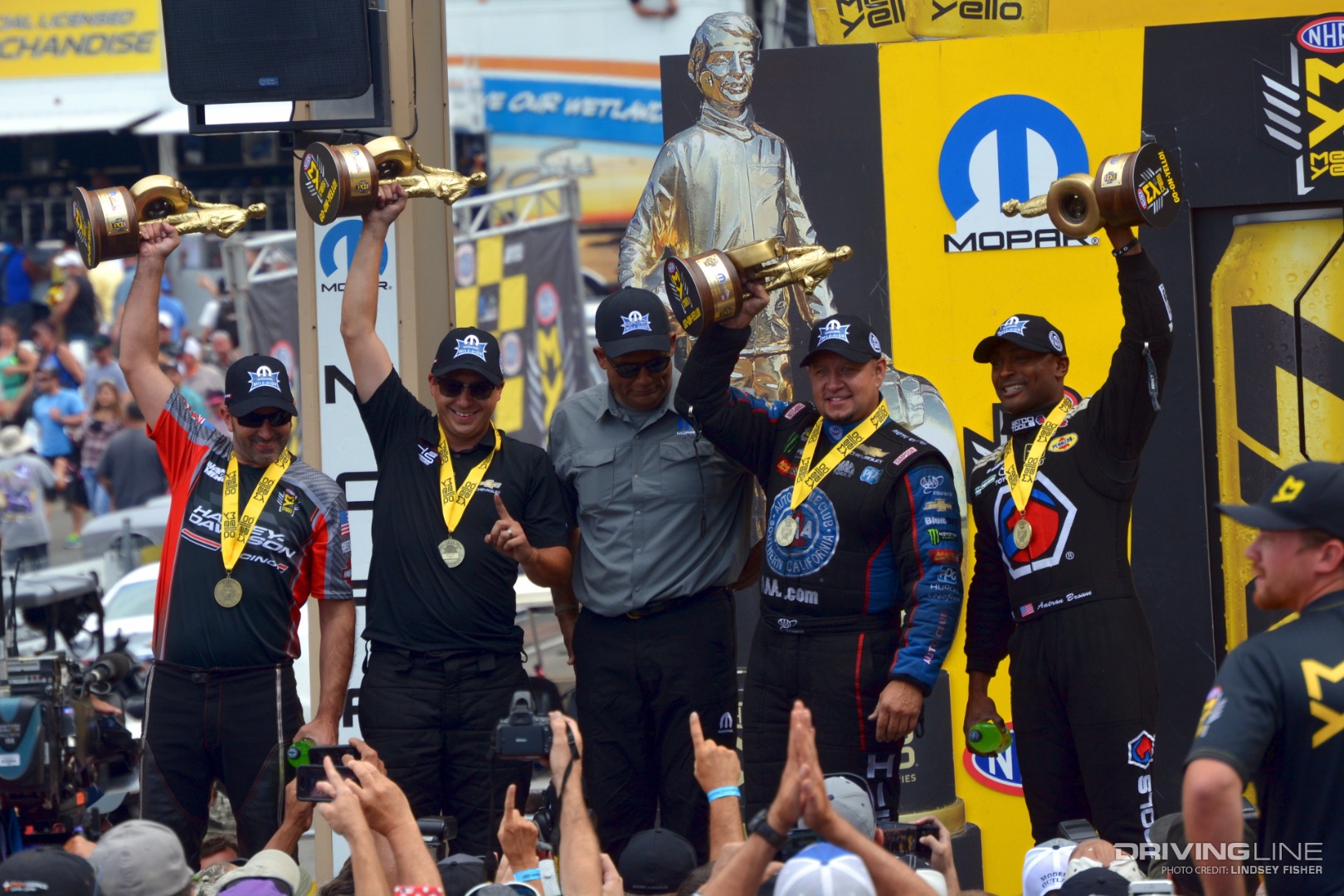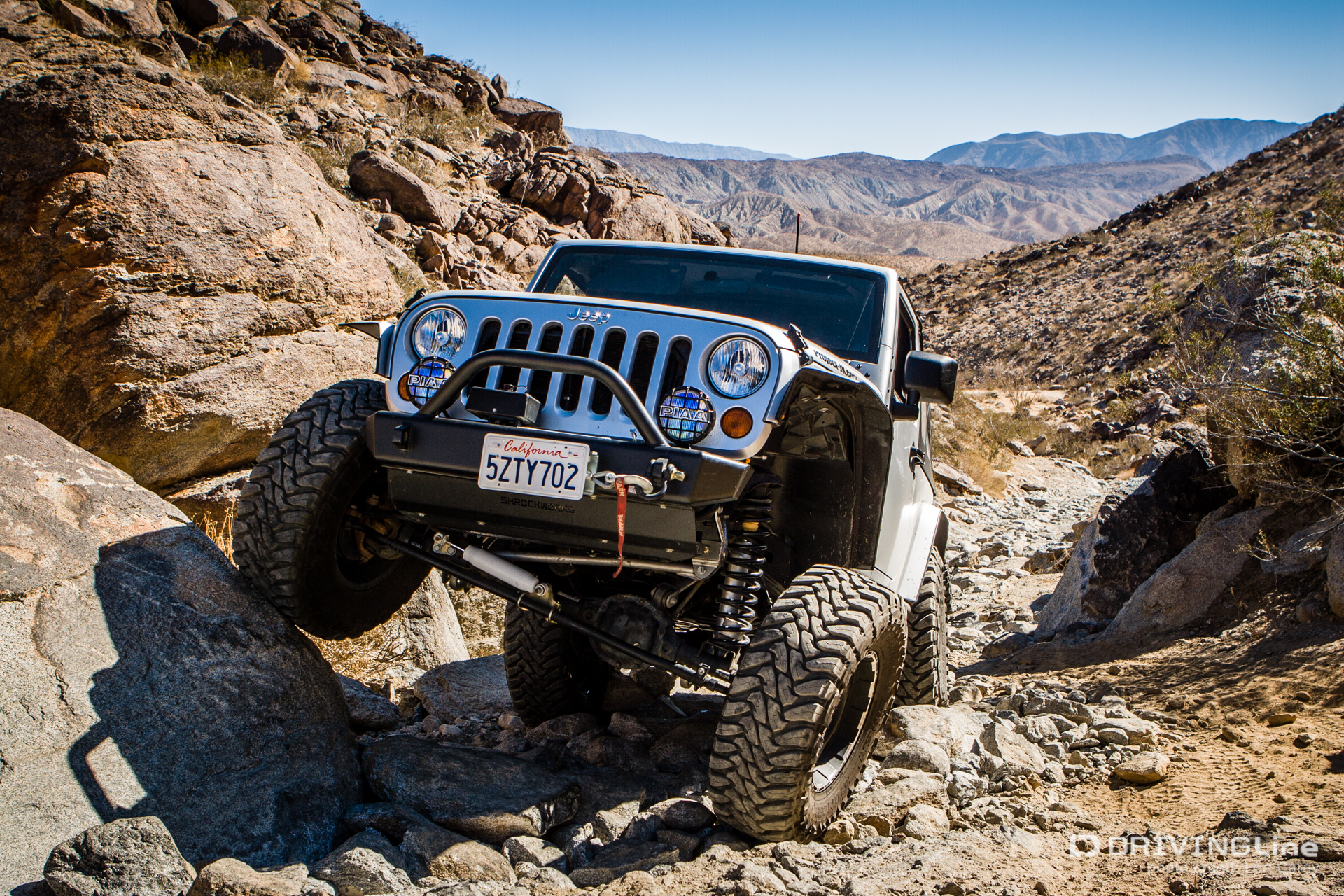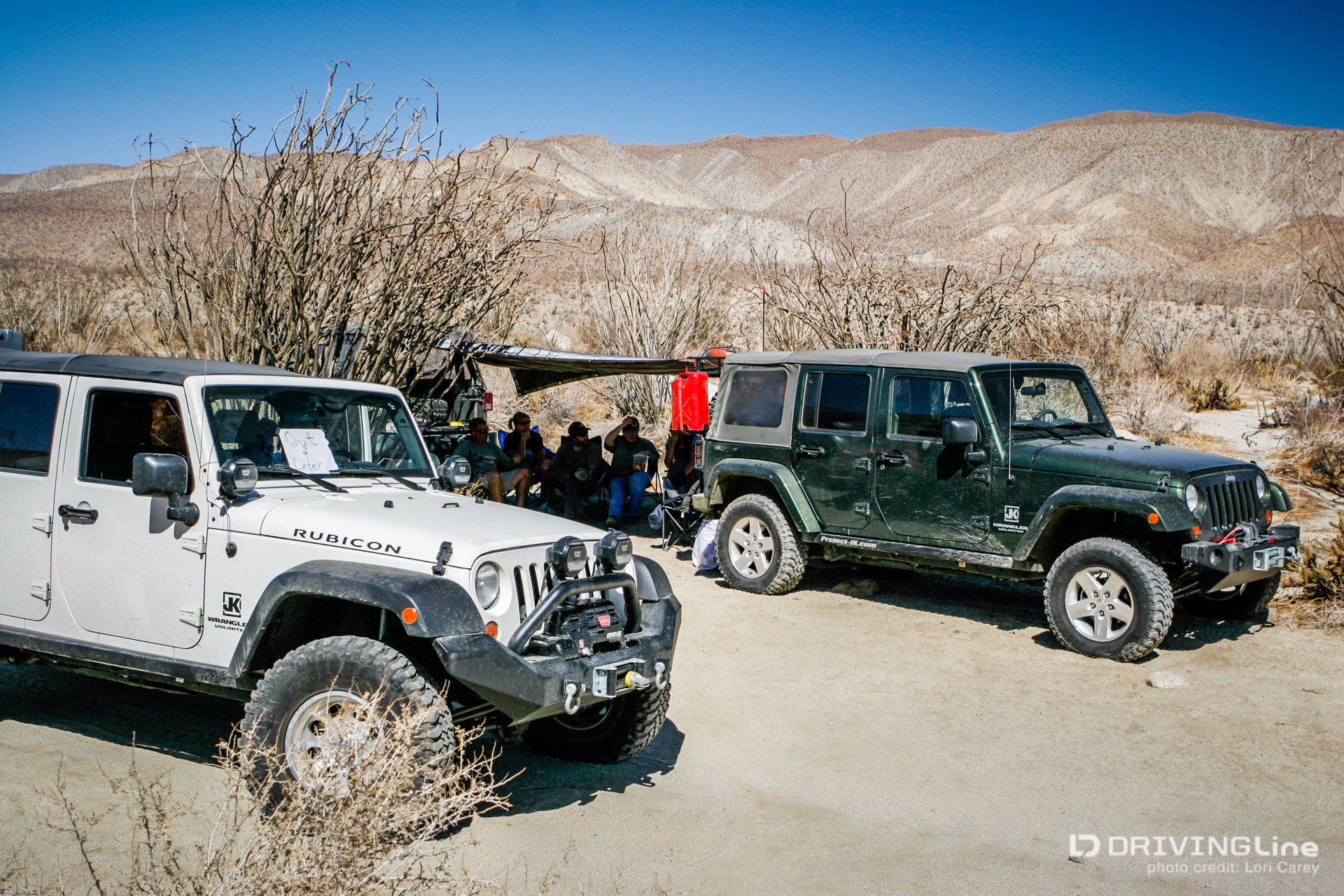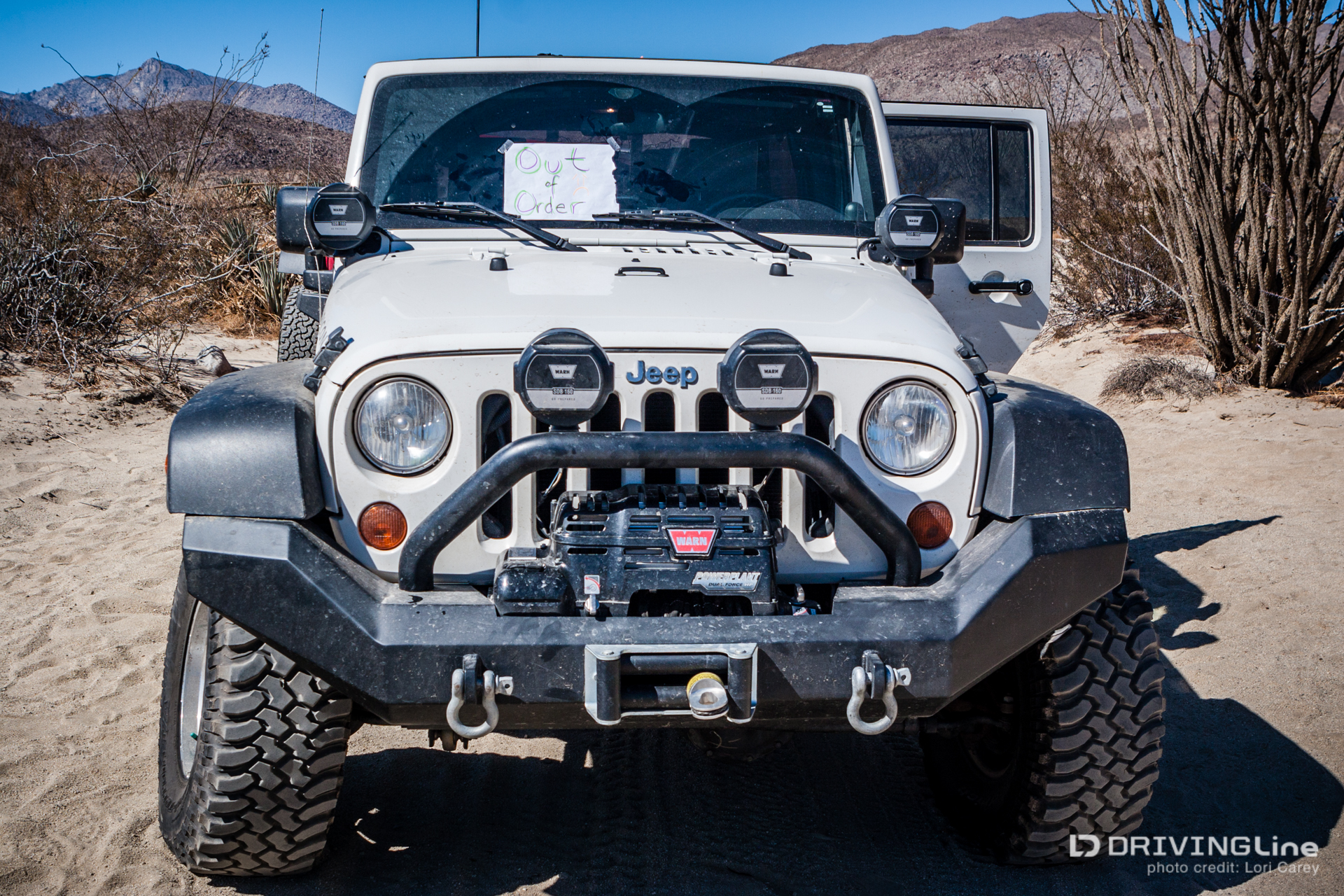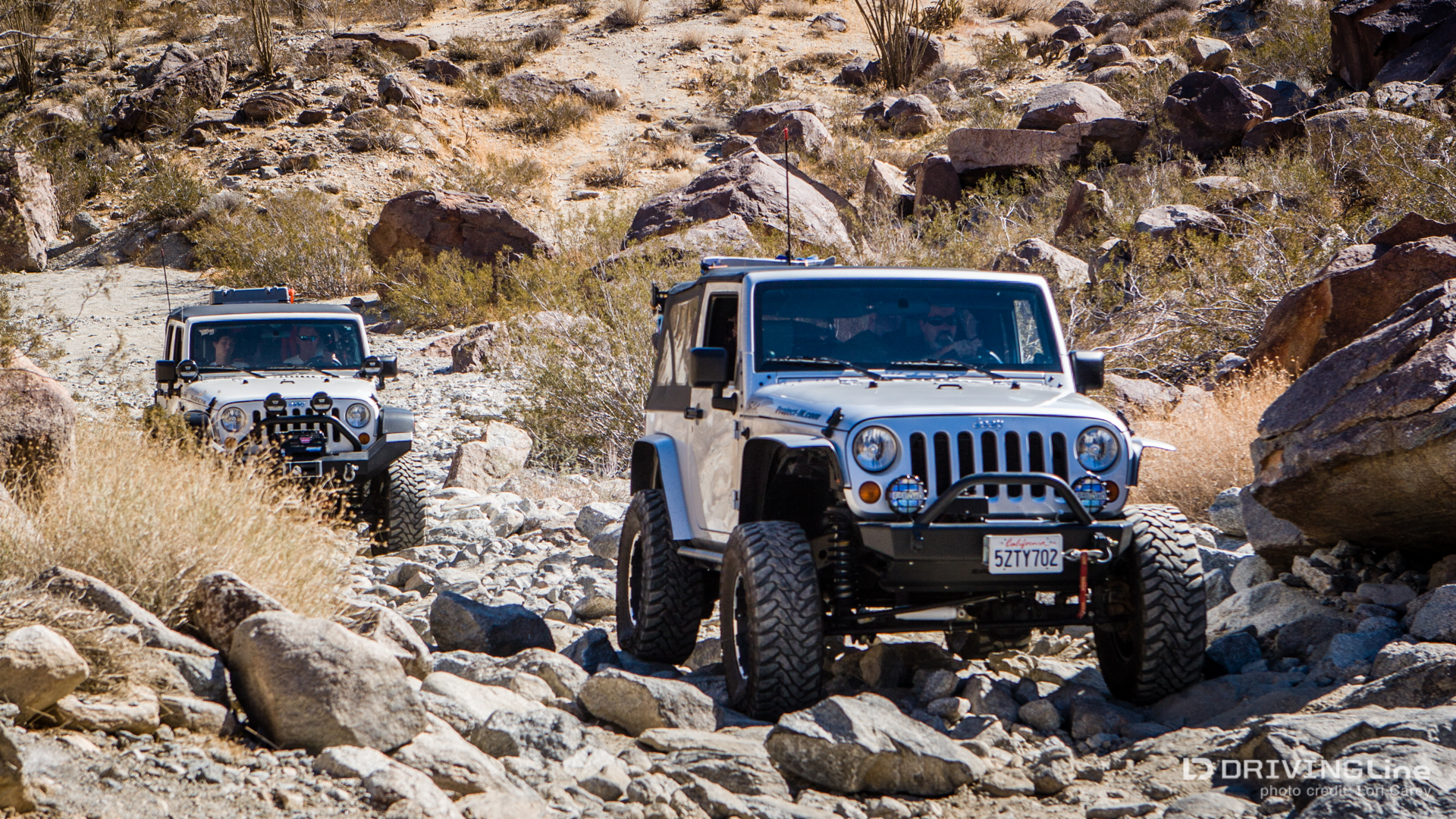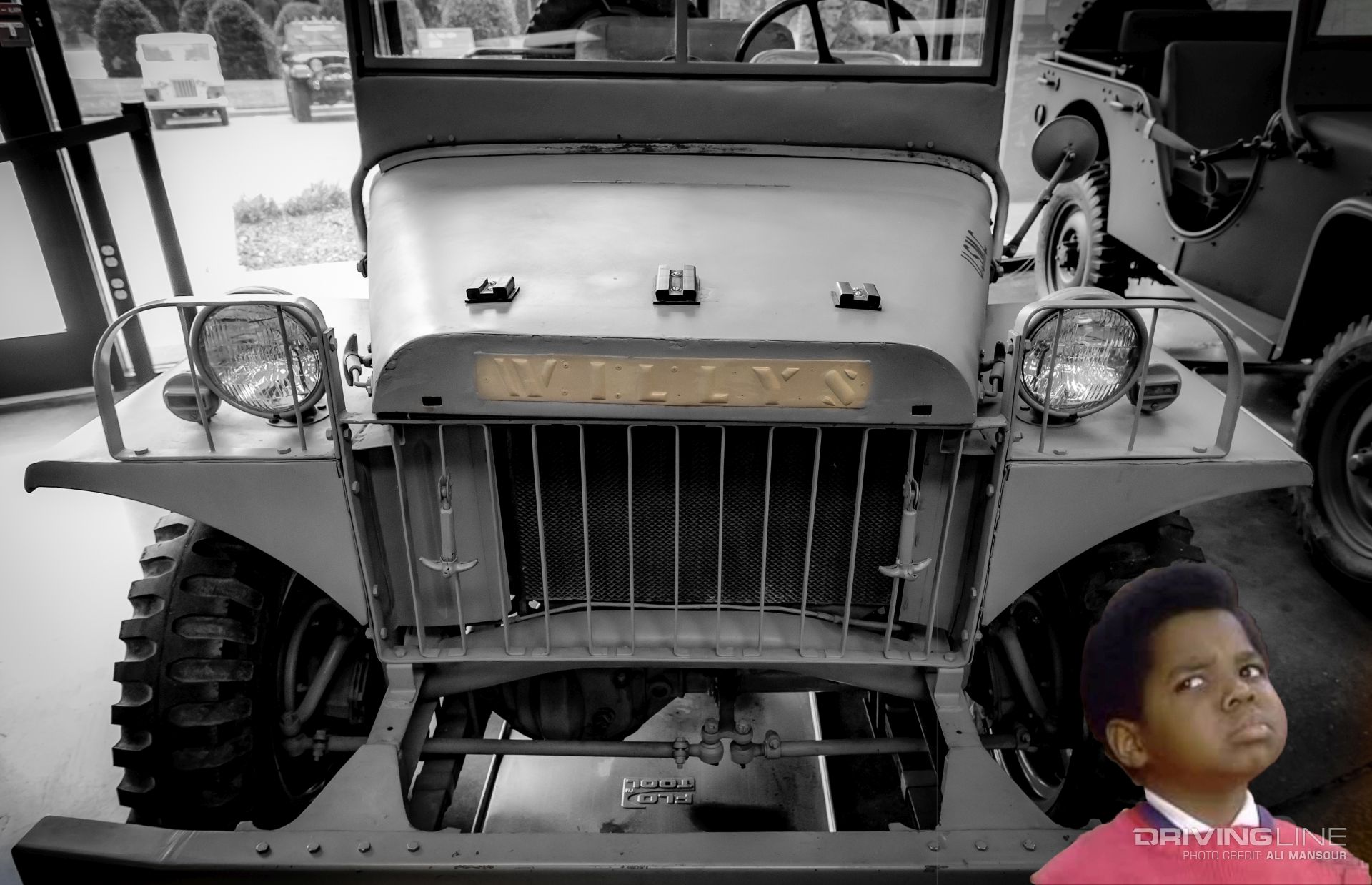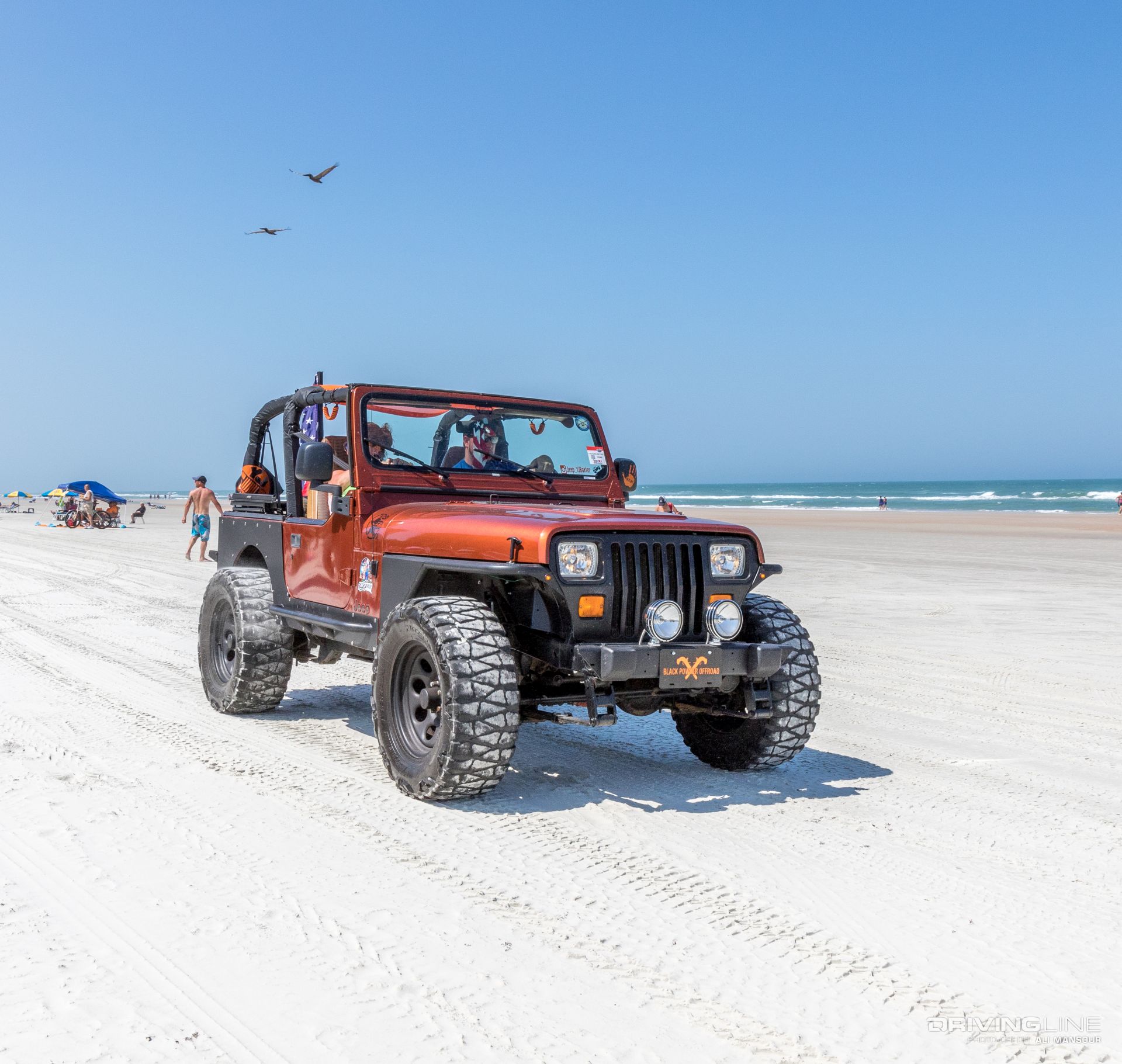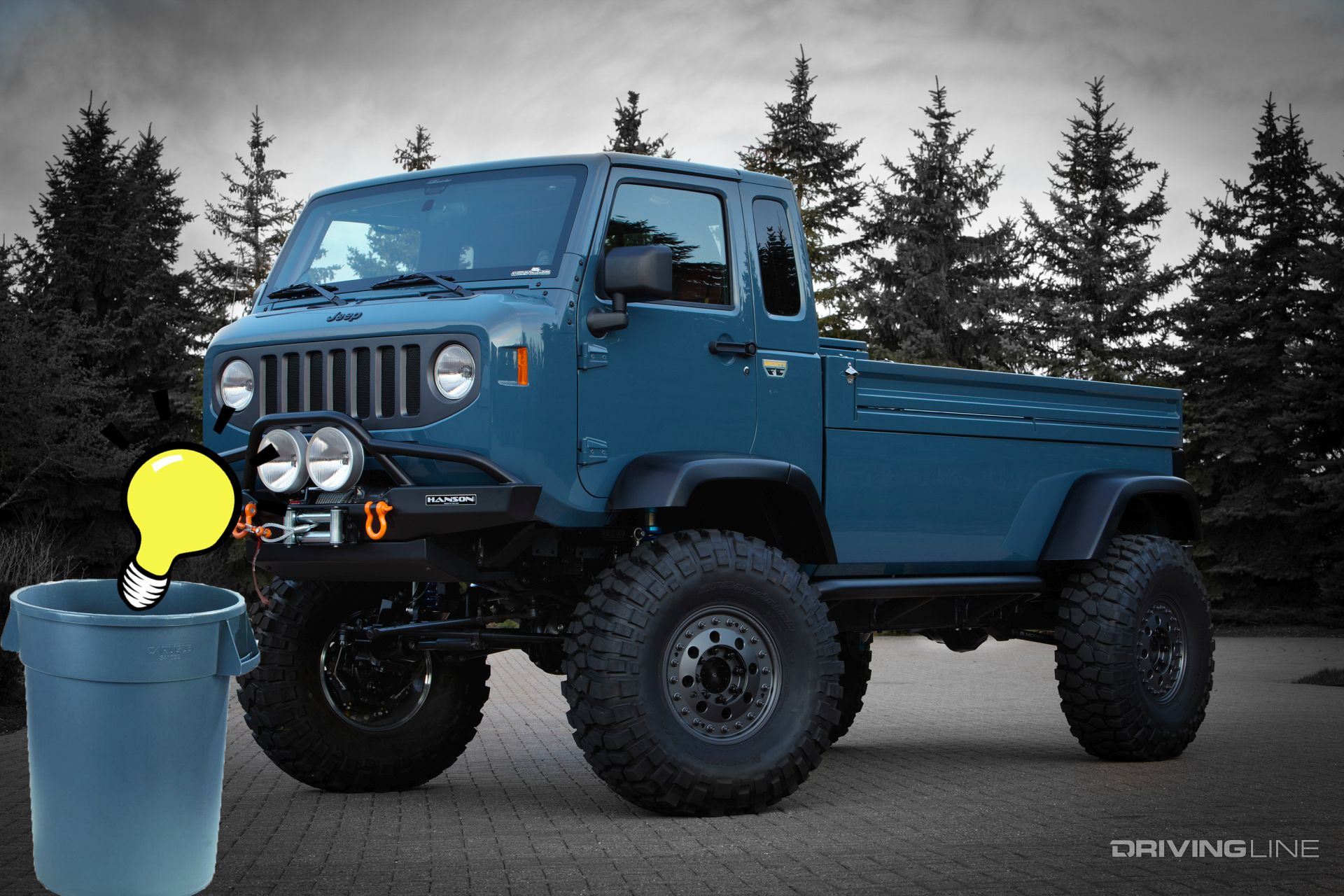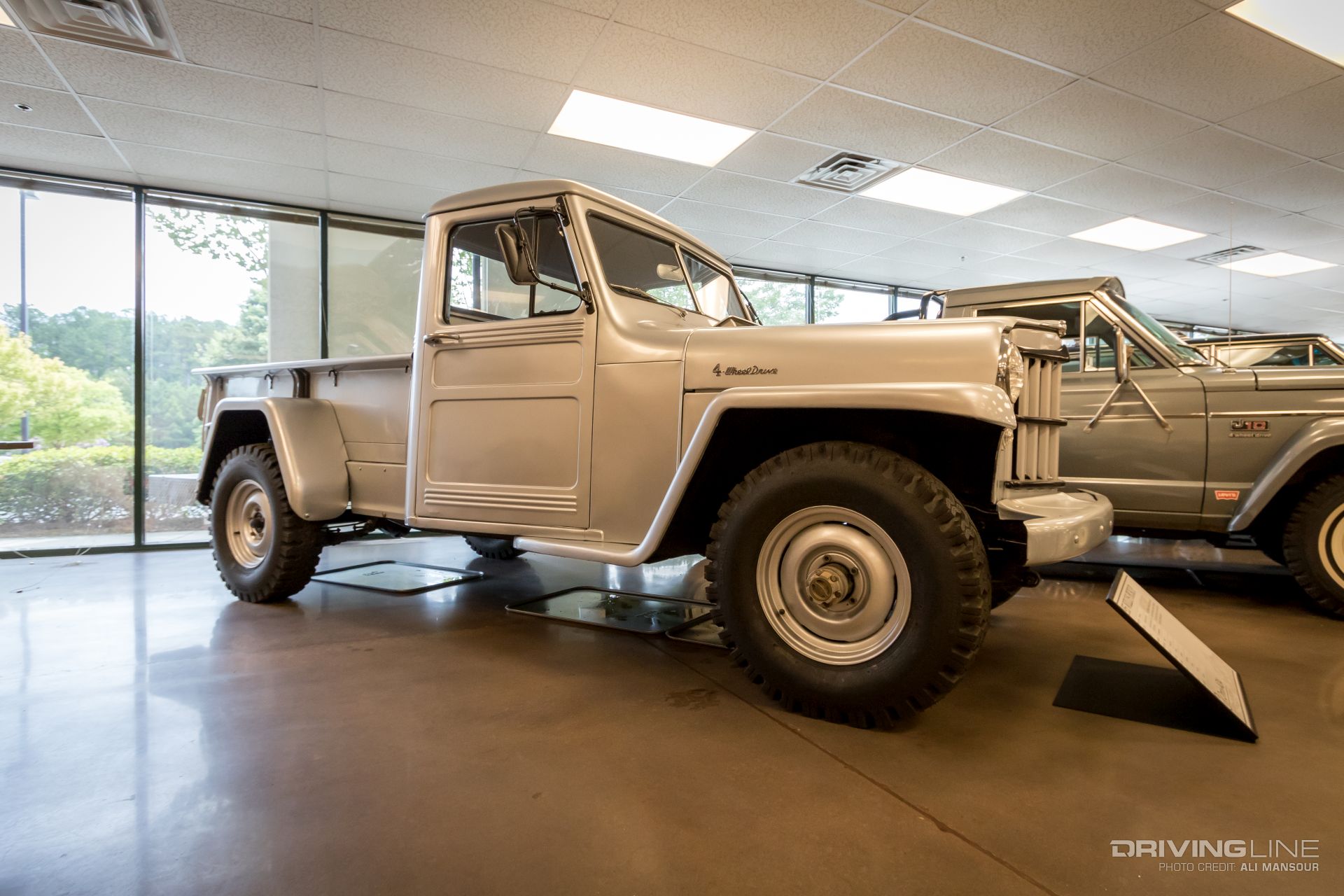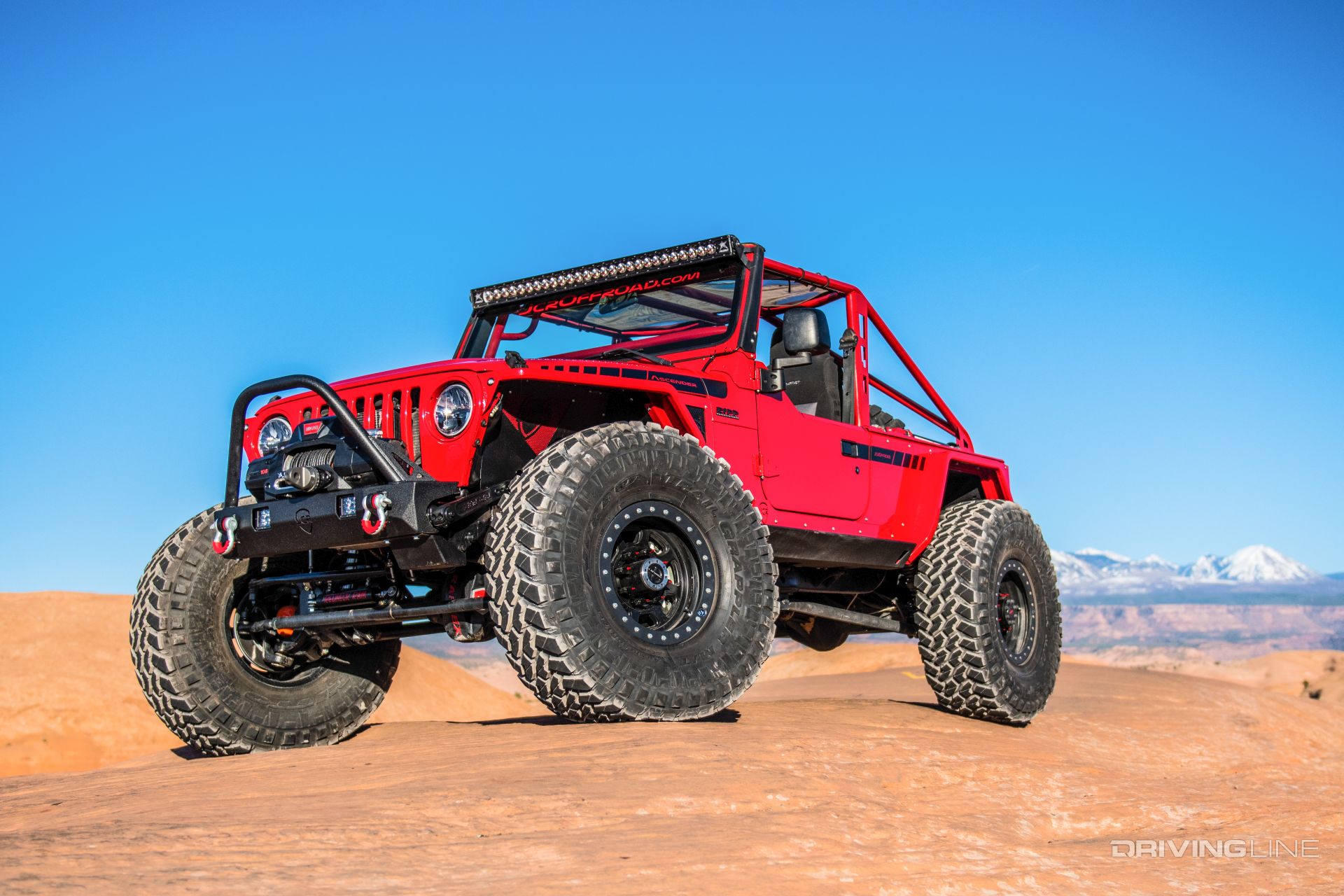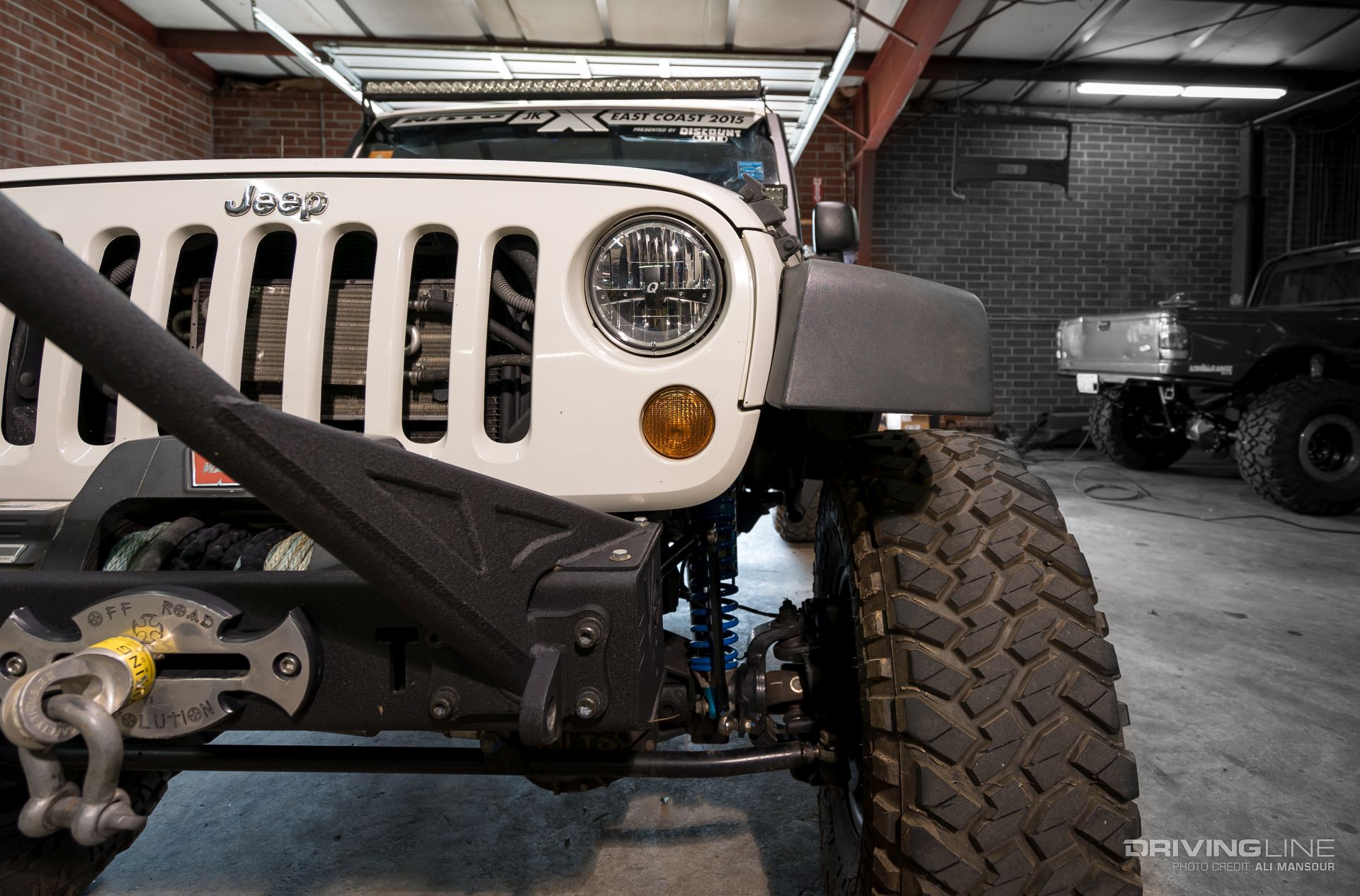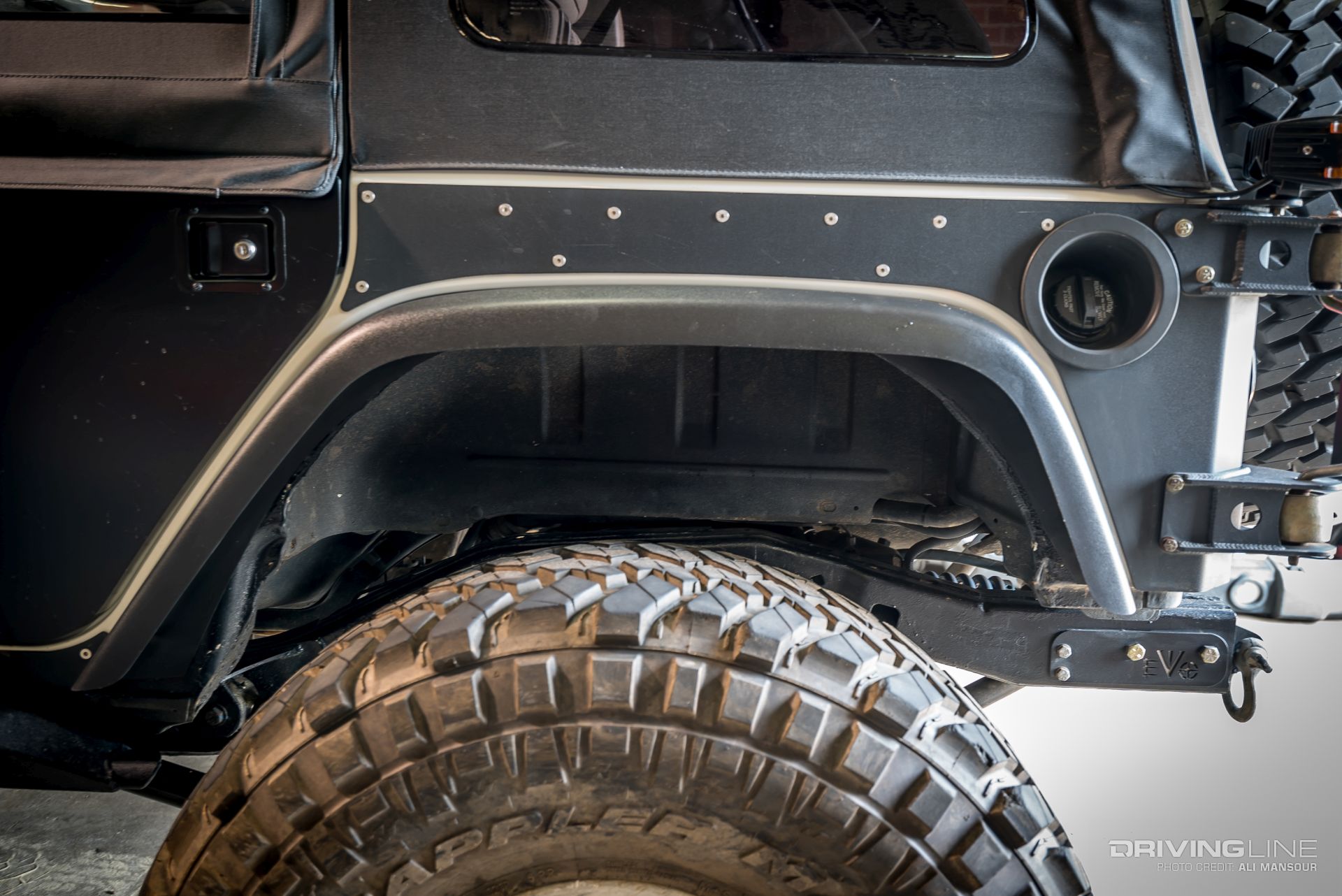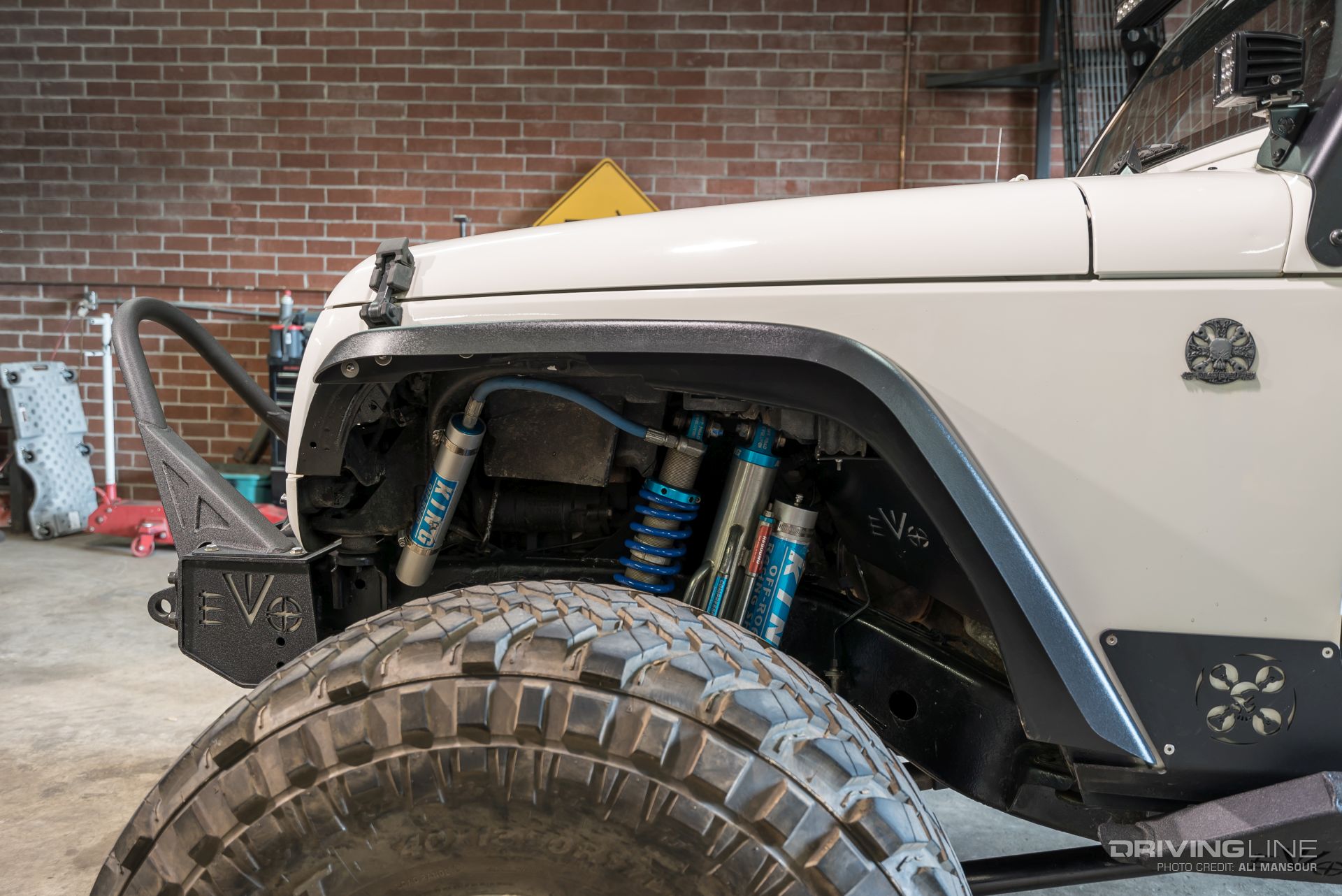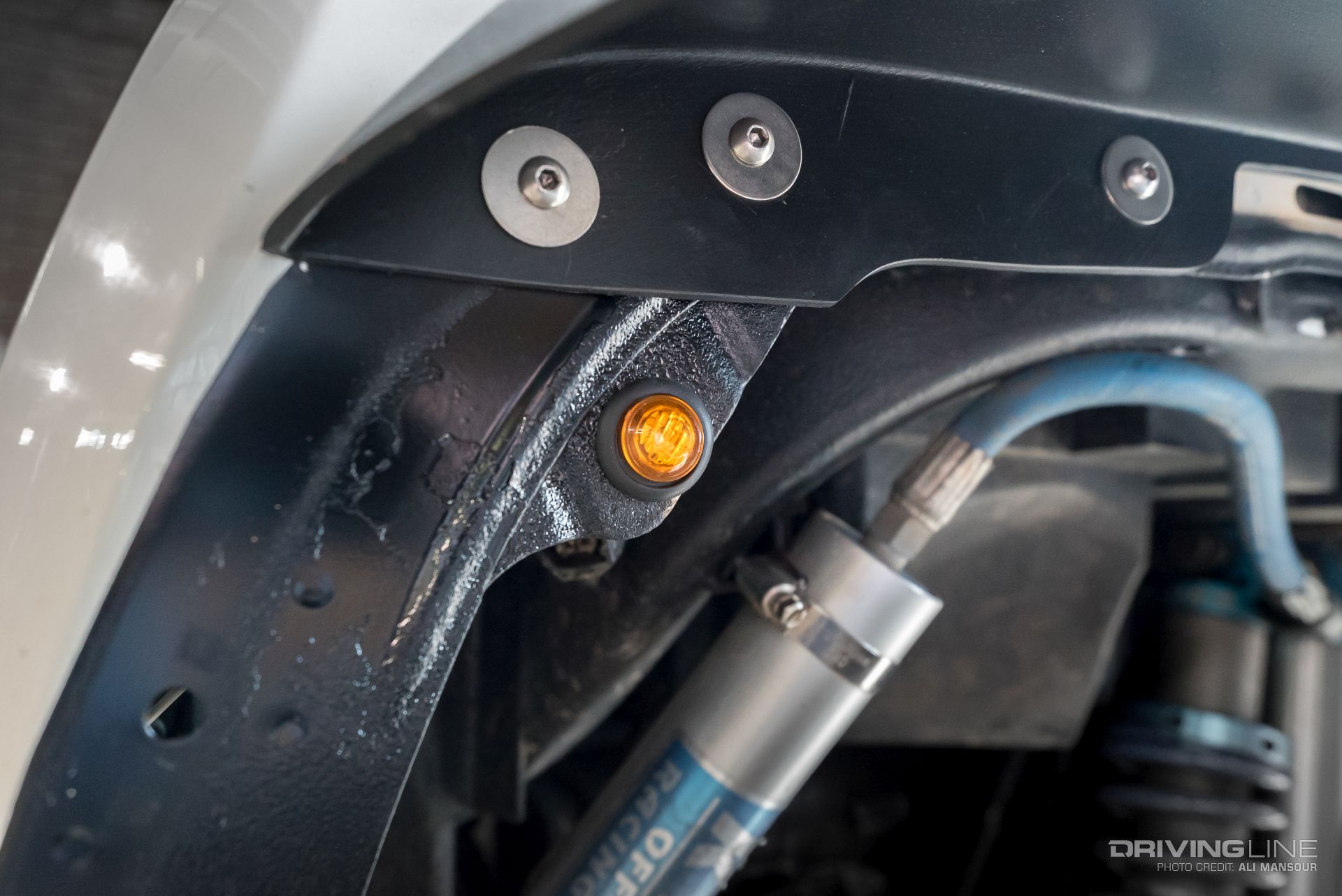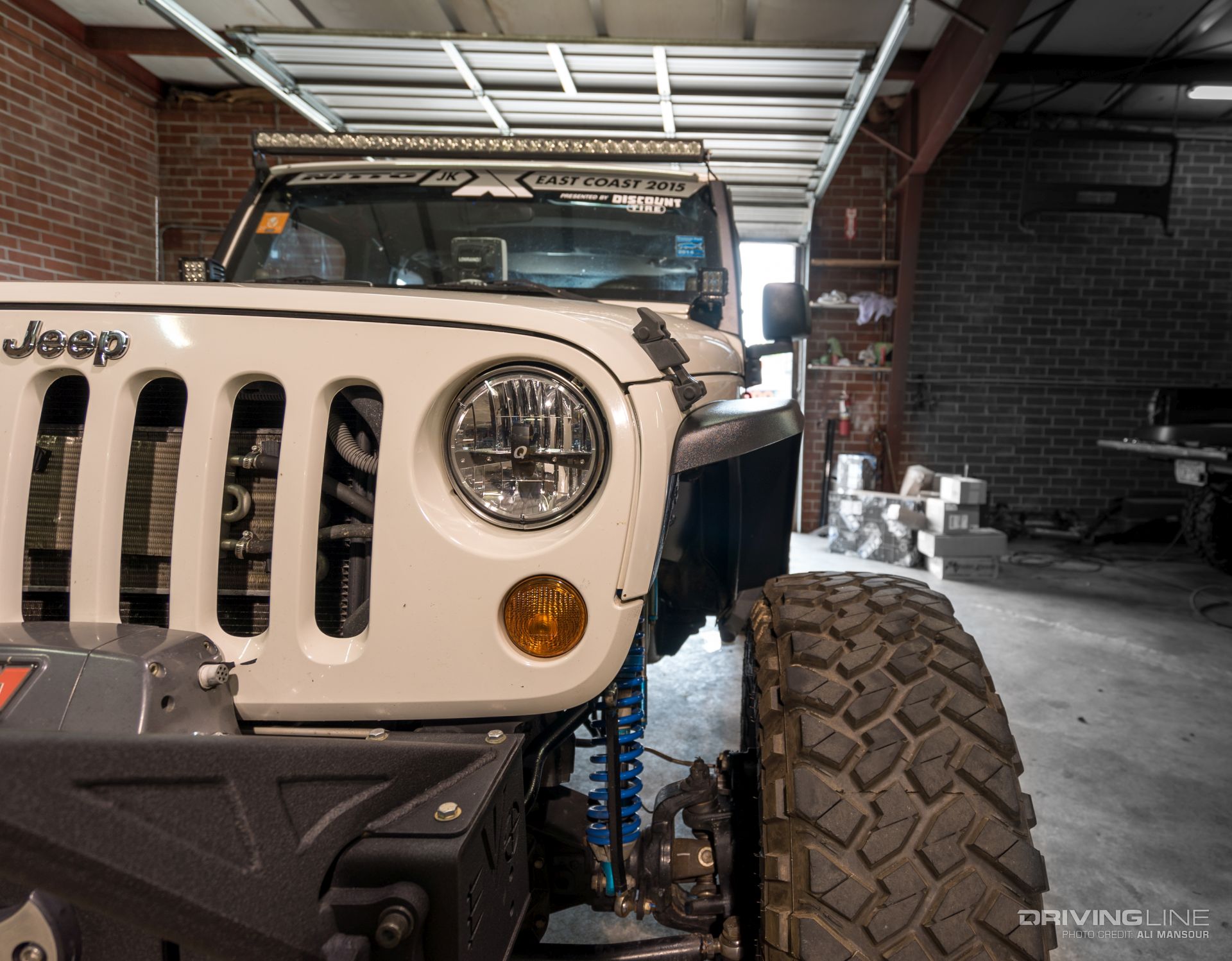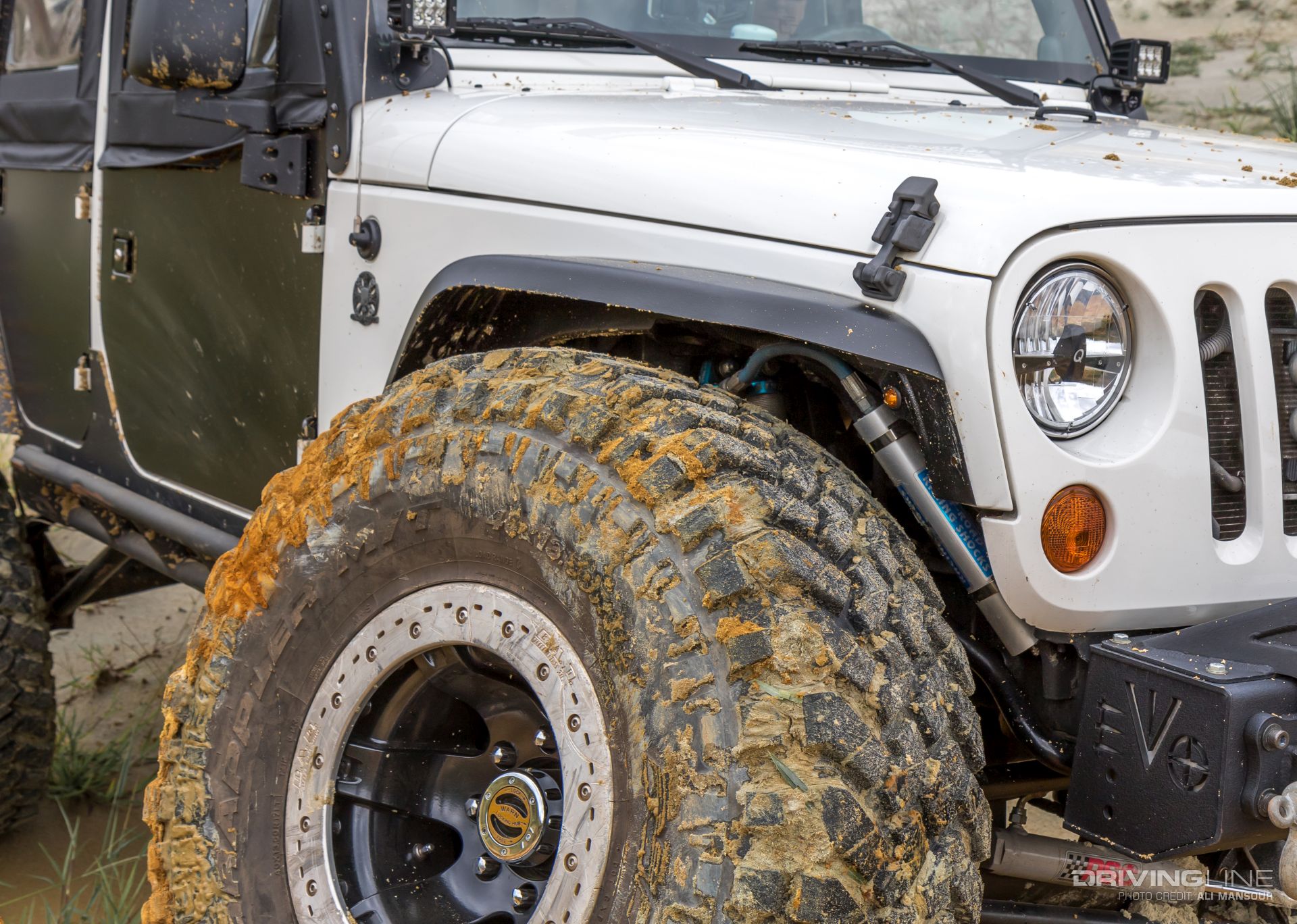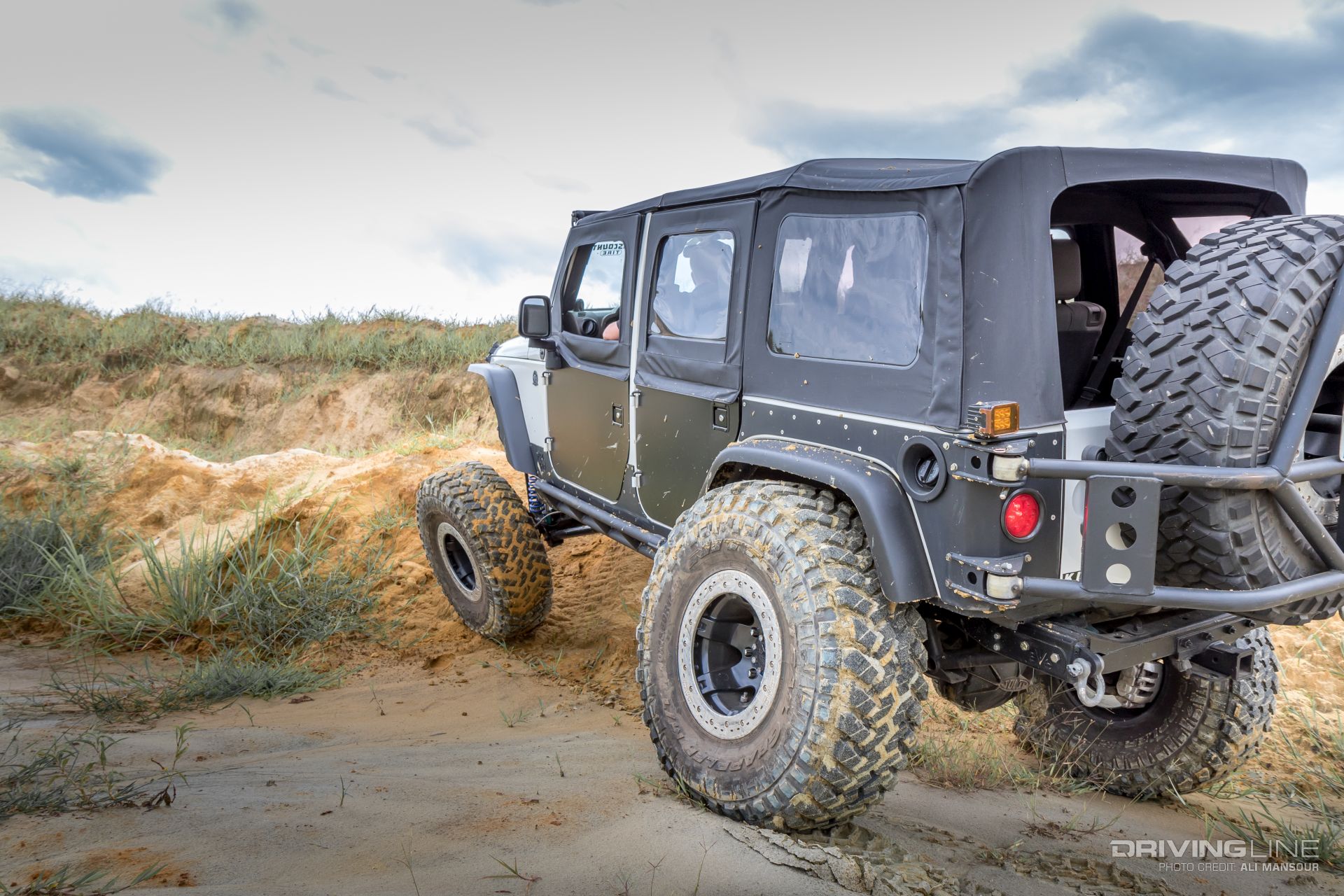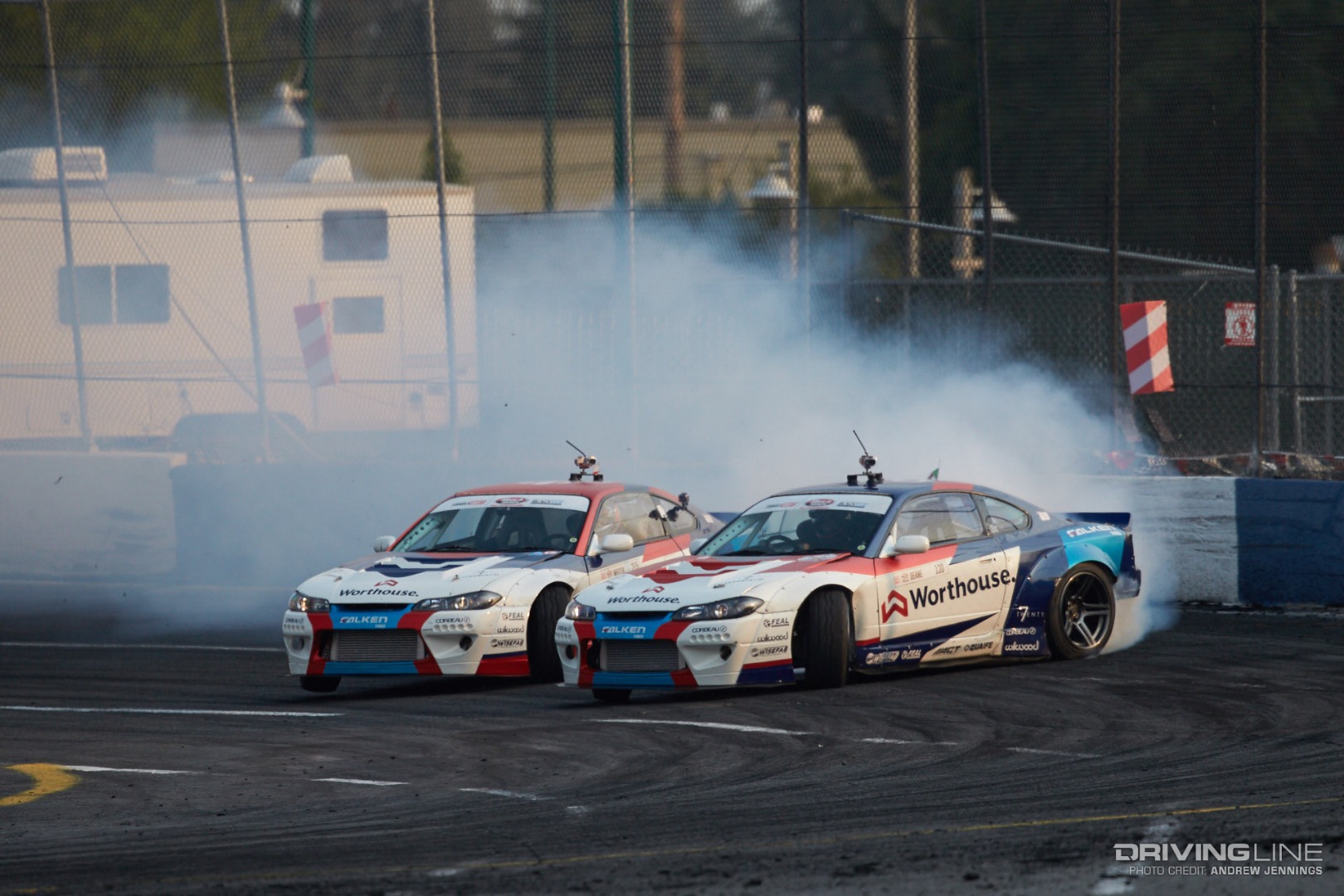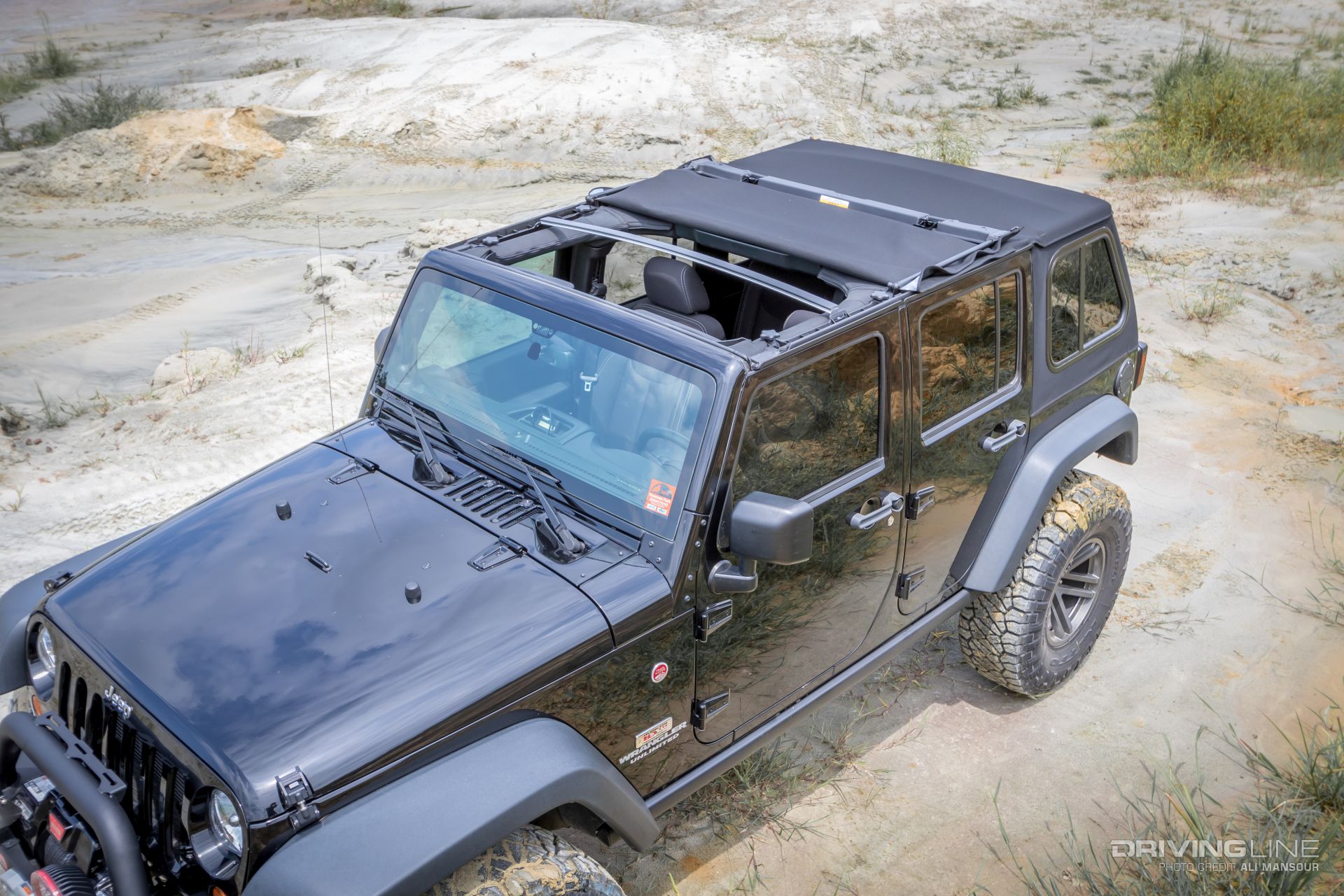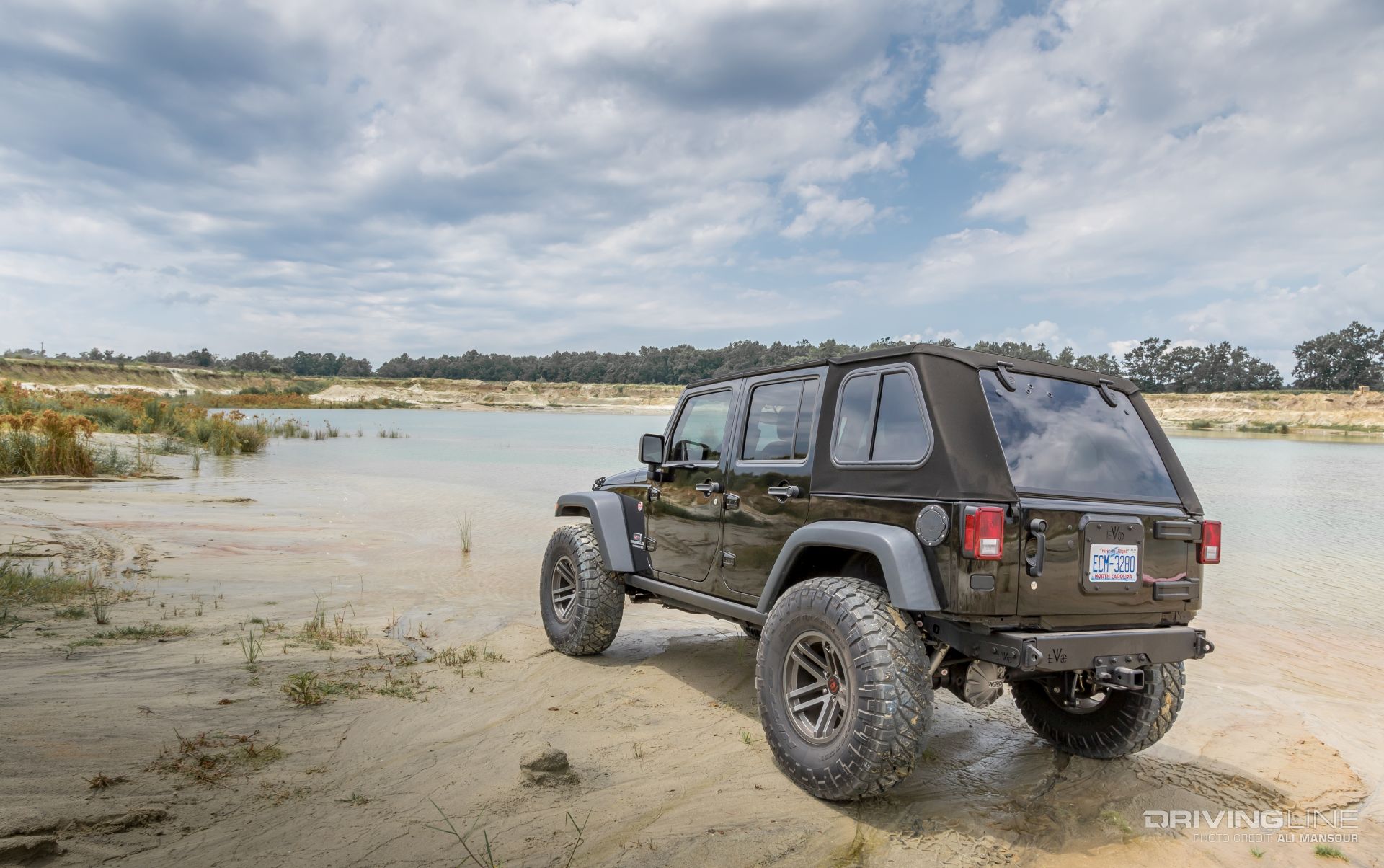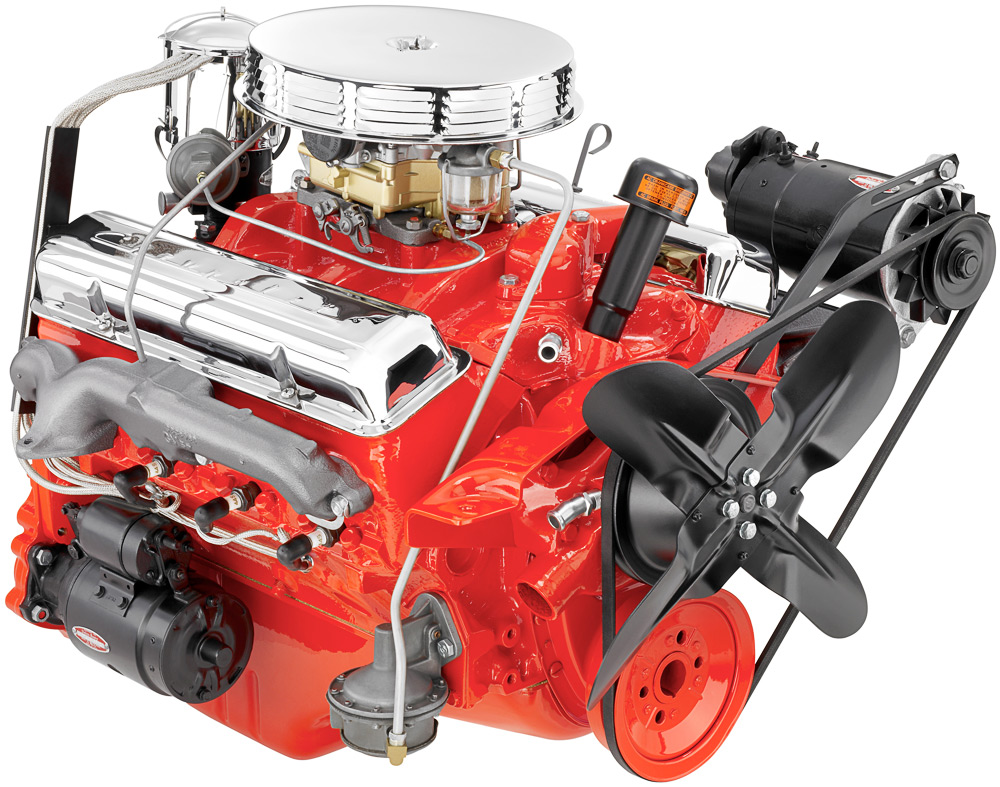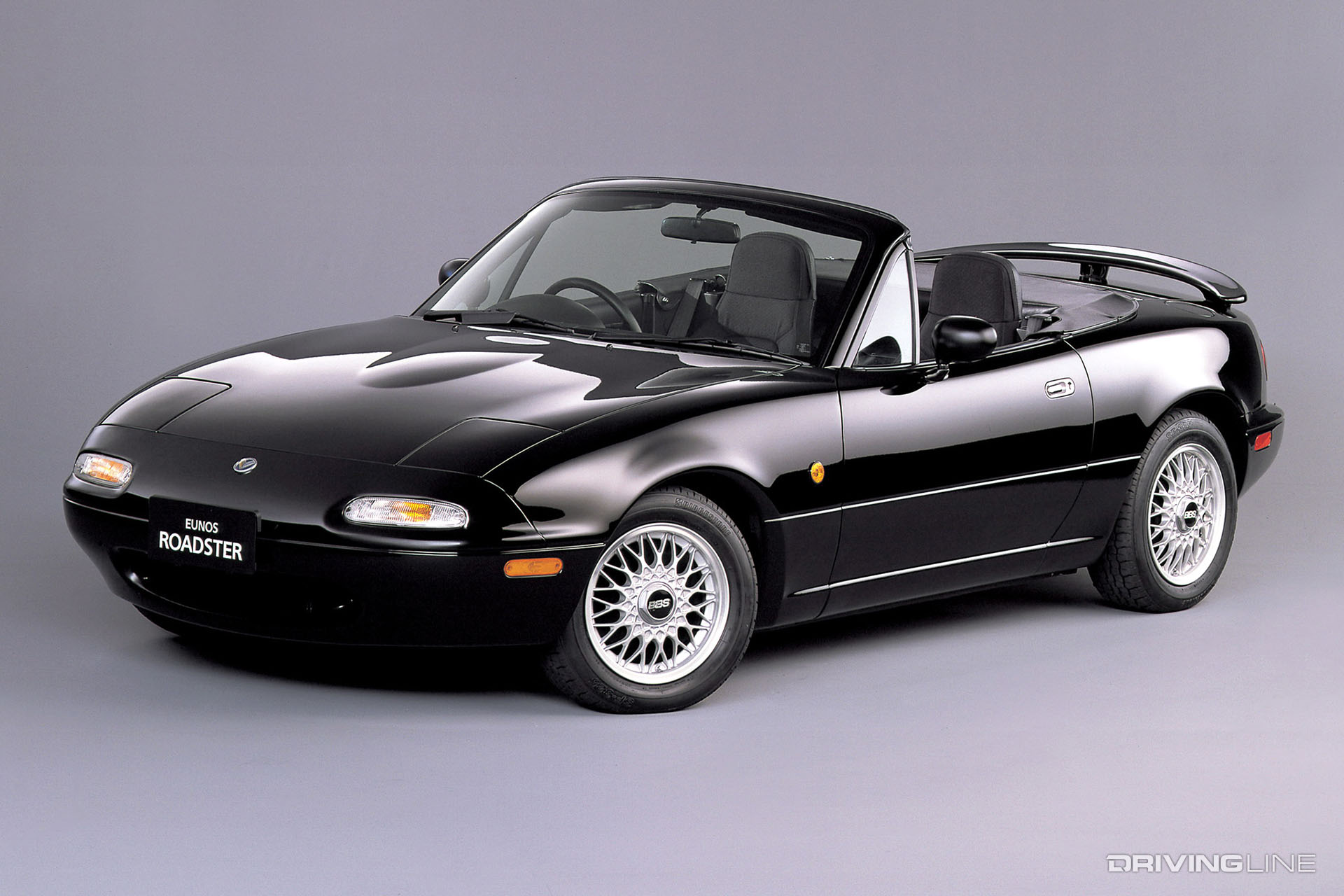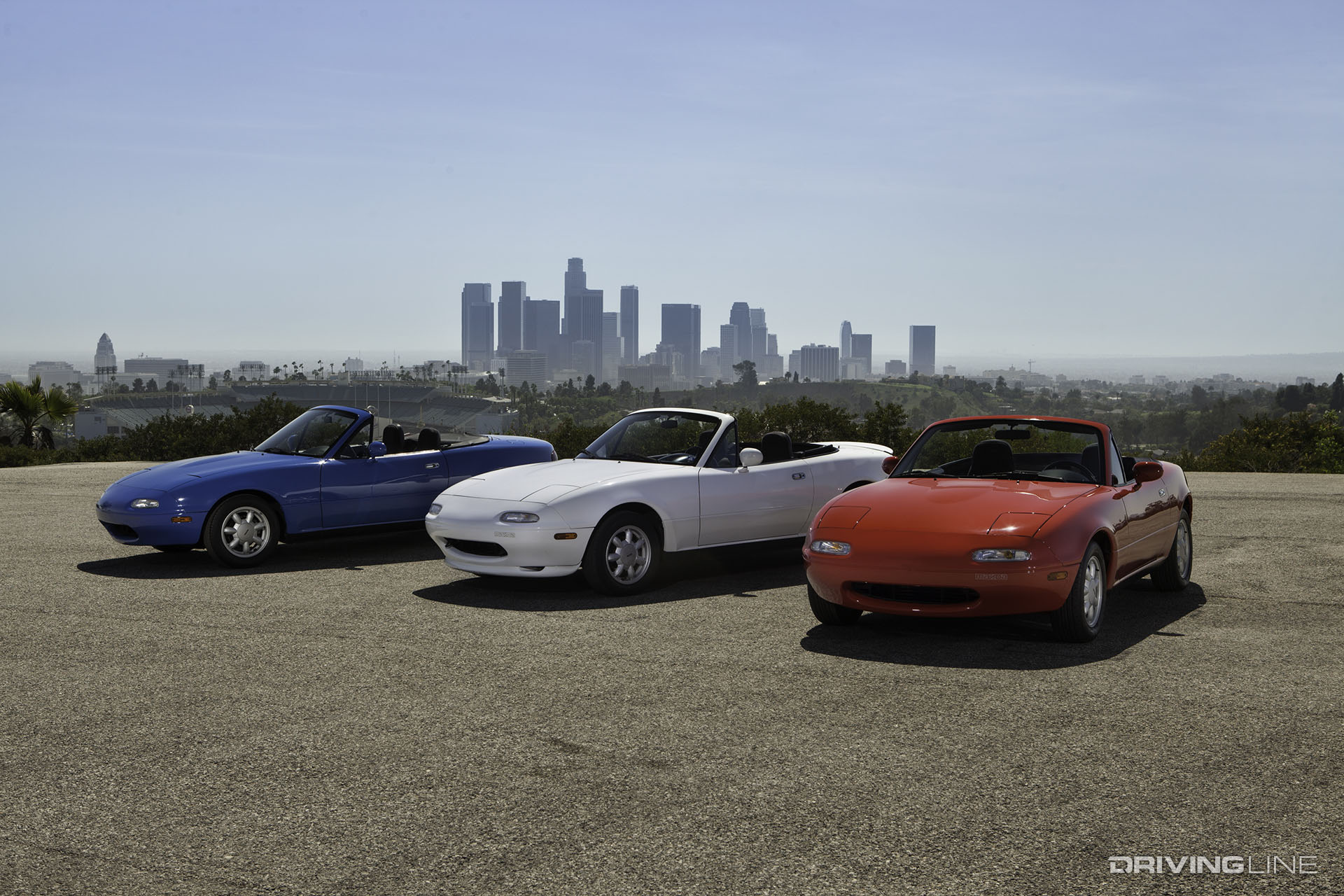Evergreen Speedway hosts the sixth stop on the 2017 Formula Drift schedule in Monroe, Washington, around 30 miles northeast of downtown Seattle. This year, the last two turns of the course were modified a bit from previous layouts in Seattle, eliminating the off-throttle “carousel” section and the hairpin that pushed drivers back near the wall in favor of two gradual radius turns that allow the cars to carry substantially more speed.
The weather in the week leading up to the event was scorching in Seattle, breaking several records. Contributing to the difficult conditions were the hazy skies due to a major forest fire in British Columbia, reducing the air quality and keeping the humidity higher than what the Pacific Northwest is used to.
QUALIFYING
Seven drivers earned a score of 90 or better in qualifying, compared to the previous round at Montreal where a score of 88 points earned the pole position. A pair of three-way ties in the top six positions meant that the scores of the lower scoring qualifying runs would help slot the drivers into the tandem brackets. With just 26 drivers starting the weekend, each of the top six drivers would earn a bye run into the Top 16.
Positions 4 through 6 composed of a trio of drivers who earned a 91-point score on their best run, but after tallying the lower scored runs, Michael Essa would earn Q4, while Kristaps Bluss and Vaughn Gittin Jr. would earn Q5 and P6, respectively.
![Vaughn Gittin Jr.]()
Ahead of them, James Deane would earn his second consecutive pole position with a primary score of 93 and a backup score of 92, showing just how consistent and precise his runs were. Ryan Tuerck and Odi Bakchis would also earn 93 point primary runs, but with lower backup scores, Tuerck would take Q2 while Bakchis would accept Q3.
TOP 32
The weather has cooled off substantially from earlier in the week, and the temperature is a pleasant 80 degrees at the start of Top 32. The crowds are filling in quickly for what is sure to be a sold-out event. The fans at Evergreen are very knowledgable and enthusiastic, and routinely give Atlanta fans a run for the money as the best on the Formula Drift schedule.
James Deane – Bye Run
DEANE LEAD – After the late crash in practice which caused Piotr Wiecek to miss his bye run in Montreal, the decision was made to allow drivers to skip their bye run. Deane will earn a few extra points as the top qualifier, which could be the difference in the championship. He’s looked pretty solid in practice, and we’re excited to see him in the tandem battles starting in Top 16.
Dan Burkett vs. Kyle Mohan
BURKETT LEAD – Burkett opens up a substantial five car lead through the big bank, Mohan is on a slightly lower line but can’t make up much ground. Mohan is able to transition a bit late in the power alley and close the gap up to Burkett, but the lead run from Burkett has great line and angle, and likely will earn an advantage. Mohan didn’t make any notable mistakes, but the lack of proximity was noticeable.
![Dan Burkett and Kyle Mohan]()
MOHAN LEAD – Burkett initiates very close to Mohan and has to slam on the brakes to avoid contact, which forces him to take a low line around most of the bank. Burkett uses the grip from his Toyota Supra to close the gap again, Mohan transitions through the power alley nicely and brushes the touch-and-go area as requested from the judges. Burkett takes a shallow line through the touch-and-go and sucks in tight to Mohan. Mohan finishes the final two turns with Burkett tight on his door. Two judges vote for Burkett to move on, one votes for a “One More Time.” Majority rules, Burkett moves on to the Top 16 to face James Deane. This is the first Top 16 appearance for Burkett in his rookie season of Formula Drift.
Alex Heilbrunn vs. Pat Goodin
HEILBRUNN LEAD – Heilbrunn has a very early initiation, Goodin initiates very late and loses drift shortly after initiation, then shuts it down and drives casually through the rest of the course. Heilbrunn continues his run with tons of smoke, bumping the wall at the end of the bank and continuing through the power alley smoothly. Goodin had a major crash in practice and was barely able to limp the car back for qualification, looks like there might be some mechanical issues that didn’t get resolved yesterday.
![Alex Heilbrunn and Pat Goodin]()
GOODIN LEAD – Goodin calls his competition timeout before this run to attempt to repair his vehicle, and is able to make the call to the start line for this second run. Goodin initiates around two car lengths ahead of Heilbrunn and looks like the repairs are working. Heilbrunn stays around two car lengths behind Goodin through the entire run, leaving some room to make adjustments should something mechanical happen with Goodin. This pass is a very strong one from Goodin, while Heilbrunn looks very comfortable in chase as well. All three judges vote for Heilbrunn to move on to the Top 16.
Piotr Wiecek vs. Dean Kearney
WIECEK LEAD – Wiecek has a good line around the bank, Kearney starts around two car lengths behind Wiecek and keeps a consistent amount of proximity to Wiecek. As Wiecek transitions through the power alley, Kearney transitions late and attacks via a shallower line. Kearney has good proximity at the infield clipping point, but loses some ground around the final two turns. Wiecek will probably earn a slight advantage, but there’s plenty of opportunity for Kearney to make a comeback in the second run and earn the tandem win.
![Piotr Wiecek and Dean Kearney]()
KEARNEY LEAD – Wiecek initiates around two car lengths ahead of Wiecek, then Kearney opens up another car length of distance on Wiecek very quicly. Kearney brushes the wall with his wing midway through the bank but doesn’t lose any steering angle and powers through it. Wiecek closes the gap through the power alley very similarly to how Kearney closed the gap, but maintains the proximity much better around the final two turns. Kearney really didn’t make any major mistakes on either run, but the proximity from Wiecek in chase was clearly superior to Kearney’s chase run. All three judges vote for Wiecek to move on to the Top 16.
Michael Essa – Bye Run
ESSA LEAD – Essa looks to be back in championship form in this BMW E46 chassis, already earning two podium finishes this season and qualifying in Q4 here at Evergreen. Essa took second place here at Evergreen back in 2013 when he won the championship, and strong results here would help make his push for a second championship this year. Essa currently sits in fourth place overall in the championship standings, and a win here could move him up as high as second.
Matt Field vs. Dai Yoshihara
FIELD LEAD – Field initiates around two car lengths ahead of Yoshihara, both drivers are on the proper line around the bank with plenty of tire smoke. Field has a bit more steering angle and dumps a lot more steering angle at the end of the bank, both drivers hit the touch-and-go wall nicely and transition into the second part of the course. Yoshihara leaves the touch-and-go a little early and ends up taking out the inside clip on the infield, Field finishes the last turn with tons of tire smoke while Yoshihara is close behind him. Great proximity from Yoshihara, perhaps a small mistake in chase taking out the inside clipping point but otherwise one of the best follow runs we’ve seen so far in the Top 32.
![Matt Field and Dai Yoshihara]()
YOSHIHARA LEAD – Yoshihara has a good initiation and Field is almost identically two car lengths behind him. Yoshihara has more steering angle at the end of the bank very similarly to what happened on the previous run, Field transitions a bit later than Yoshihara through the power alley and spins out!
Looking at the replay, it looks like Field was expecting Yoshihara to be faster through the touch-and-go than he was, but the judges noted that this area was a deceleration zone, which will probably work against Field. Yoshihara finished the final two turns smoothly, so the decision will come down to how the judges see the spin. All three judges vote for Yoshihara to move on to the Top 16.
Kristaps Bluss – Bye Run
BLUSS LEAD – Bluss is having a banner year in his Monster E46 BMW, and this weekend looks to be no different. What’s scary is how fast Bluss’ car is while in drift. Many of the cars on the grid have a ton of forward grip, but the sideways grip in his car is incredible to watch.
Matt Coffman vs. Robbie Nishida
COFFMAN LEAD – Coffman initiates on the high line, Nishida initiates a bit later and on a lower line. Coffman has a good line around the bank, Nishida remains around three car lengths behind Coffman but on the lower line. Nishida’s line allows him to close the gap slightly near the end of the sweeper, then uses a quicker transition and a shallower line through the power alley to keep the proximity close. Coffman hits the touch-and-go line nicely and has a good line through the infield and the final turn, this run will likely be scored as a slight advantage for Coffman due to his precise line around the course.
![Matt Coffman and Robbie Nishida]()
NISHIDA LEAD – Coffman left a few car lengths of distance on Nishida in the run up to the first turn, then initiates around three car lengths behind Nishida. Coffman uses the lower line to close the gap to Nishida, then sucks in tight by braking late through the power alley to suck in to within a single car length of Nishida around the final two turns. The bank portion of both runs looked very similar, but Coffman was clearly superior through the infield portion of the course while in chase. All three judges vote for Coffman to earn the win into the Top 16.
Ryan Tuerck – Bye Run
TUERCK LEAD – Tuerck started the season strong with a Top 4 finish in Long Beach and a pair of Top 8 finishes in Orlando and Atlanta, but has been knocked out in the Top 16 round at the last two events. With the high qualification, he will be guaranteed a Top 16 finish, but hopes to break through and make it back to the podium. Tuerck last saw the podium in Seattle in the Gardella Racing Pontiac Solstice back in 2012, but he knows his Toyota GT86 is capable of making a podium run.
Nate Hamilton vs. Justin Pawlak
HAMILTON LEAD – Hamilton initiates early and opens up a four car gap on Pawlak early in the bank, but Pawlak closes the gap down to around two car lengths while taking a good line around the bank. Hamilton has a good transition through the power alley, Pawlak is a bit off the touch-and-go area but stays around two car lengths behind Hamilton around the final two turns. Hamilton did what he was requested to do as the lead car, while Pawlak definitely left more room than he should have in the chase position.
PAWLAK LEAD – The initial attempt at the second pass is halted just before initiation as it looks like Hamilton impeded on Pawlak’s line as the lead car. This will count as a strike against Hamilton, but our second attempt at the run is clean. Pawlak uses a manji entry to initiate into the bank, Hamilton remains in his lane and initiates around two car lengths behind Pawlak. Hamilton keeps around two car lengths behind Pawlak around the bank, then uses the momentum of the car to slide up the bank near the exit and suck in tight to Pawlak.
![Justin Pawlak with Nate Hamilton crashed]()
It looks like Hamilton got lost in the smoke of Pawlak and taps the wall at the end of the bank, which pivots the front end of the car into the wall, disabling Hamilton’s car. Pawlak remains clear of Hamilton and continues drifting through the power alley and around the final two turns smoothly. Hamilton emerges from his car and waves to the crowd to indicate he’s OK, but will require a tow off the course. All three judges vote for Pawlak to move on to the Top 16.
Fredric Aasbo vs. Alec Hohnadell
AASBO LEAD – Aasbo initiates and stays high on the bank around two car lengths ahead of Hohnadell, Hohnadell stays around two car lengths behind Aasbo as both cars exit the big bank. Hohnadell continues to apply pressure through the power alley and attacks Aasbo’s door at the inner clip on the infield, but has to back off and loses drift from being over-aggressive. Aasbo finishes the last two turns smoothly and will earn a major advantage going into the second run.
![Alec Hohnadell and Fredric Aasbo]()
HOHNADELL LEAD – Hohnadell initiates around two car lengths ahead of Aasbo, proximity stays consistent through the bank at around two car lengths. Hohnadell dumps a ton of steering angle at the exit of the bank and possibly slides past the course limits, but stays on throttle and attacks the touch-and-go nicely. Aasbo stays close to Hohnadell through the power alley and is just a single car length behind Hohnadell for the final two turns. All three judges vote for Aasbo to move on to the Top 16.
Chris Forsberg vs. Jhonnattan Castro
FORSBERG LEAD – Forsberg initiates and keeps the high line around the bank, Castro has slightly shallower steering angle and slowly closes the gap down from two car lengths to a single car length by the end of the bank. Forsberg slides up on the bank and taps the wall near the exit, but keeps the gas pedal floored and maintains drift. Forsberg transitions a little later than planned in the power alley due to his line exiting the bank, but has a good line through the touch-and-go and infield inside clipping point. Castro loses some ground and scrambles to try and make up some proximity on the final turn, but takes out the final inside clip in the process.
![Chris Forsberg and Jhonnattan Castro]()
CASTRO LEAD – Forsberg immediately sucks in tight to Castro shortly after initiation and maintains good proximity through the bank Castro has more steering angle at the exit of the bank, but the proximity from Forsberg is the best we’ve seen all day. Forsberg leaves just enough room for Castro to transition through the power alley, then tucks in tight on Castro’s door by the infield inside clip and keeps that proximity around the final two turns. This isn’t a bad run from Castro, but the following run from Forsberg was masterful! Two judges vote for a “One More Time,” one judge votes for Forsberg to move on. We’ll see these two battle again!
One More Time
FORSBERG LEAD – Forsberg has big angle on the bank, Castro has shallower steering angle but incredible proximity less than a car length behind Forsberg. Castro might have made contact with Forsberg midway through the bank, but both drivers do a great job maintaining drift. Forsberg dumps big angle exiting the bank, then extends the proximity to around two car lengths through the power alley. Forsberg has a good line through the touch-and-go, then has a good line through the infield inside clip and the final turn. Castro had an amazing run on the bank, but losing proximity on the second half of the course may work against him.
CASTRO LEAD – Castro has a good initiation and Forsberg is around a single car length behind him. Forsberg doesn’t attack Castro on the bank as aggressively in chase, but does have more steering angle and line. Castro transitions nicely through the power alley and slides a bit wide from the infield inside clip, Forsberg stays consistently around a single car length behind Castro but can’t close the gap down much. This was a good clean run from both drivers. Two judges vote for a “One More Time,” one judge votes for Forsberg. We’re going to see these two run again!
One More Time x2
FORSBERG LEAD – Forsberg initiates with Castro right behind him, about a single car length away. Castro aggressive applies pressure through the entire bank, staying within a single car length of Forsberg. Forsberg shows big steering angle at the exit of the bank, Castro follows his line masterfully and both drivers enter the power alley cleanly. Forsberg fills the touch-and-go, while Castro stays on his door through the inside clip and around the final turn of the course. This is a much more controlled and purposeful chase run from Castro, as opposed to the jerky, correction-filled chase run he had in the previous tandem battle.
![Chris Forsberg and Jhonnattan Castro]()
CASTRO LEAD – Forsberg initiates just a car length behind Castro, almost identical to the previous run. Castro has a few small corrections from the lead position, but Forsberg is able to maintain much better proximity than in the previous run. Both drivers enter the power alley side-by-side, Forsberg allows just enough room for Castro to transition then attacks Castro’s door near the touch-and-go. It looks like Forsberg is coming in too hot and has to slam on the brakes, which causes him to stall out just behind Castro near the infield inside clip.
Castro finishes the course smoothly and will earn the victory. All three judges vote for Castro to move on. This was a great set of runs from Castro. Looking at the replay, it looks like Forsberg actually made contact with Castro in the deceleration zone, which was clearly communicated during the morning judges meeting.
Odi Bakchis – Bye Run
BAKCHIS LEAD – Bakchis is the defending event winner from Evergreen, and his car looks dialed in and ready to make another podium run. Bakchis has been fluctuating between getting knocked out in the Top 32 round, and making Top 8 appearances. Since he’s at least guaranteed a Top 16 appearance with the bye run, nobody should be surprised if he makes a podium appearance.
Ken Gushi vs. Cameron Moore
GUSHI LEAD – Gushi initiates around two car lengths ahead of Gushi, there are some distinct steering angle adjustments from Moore on the big bank. Gushi transitions in the power alley a little early and doesn’t fill the touch-and-go as much as the judges would like to see, but has a good run through the infield clipping point and the final turn. Moore is around three car lengths behind Gushi through the power alley and the final two turns, but overall has a good run outside of the small steering correction on the bank.
MOORE LEAD – Moore has tons of angle and is on the high line around the bank, Gushi has very shallow steering angle and is noticeably lower on the bank. Gushi taps the left-foot brake to try and slide the car higher on the bank, keeping around a single car length of proximity behind Moore. Moore fills the touch-and-go area much better than Gushi did in his lead, and has a good line with tons of tire smoke around the final two turns. Since these cars are the same chassis, it’s fairly obvious when one has more steering angle than the other. All three judges vote for a “One More Time” in this battle.
One More Time
![Cameron Moore and Ken Gushi]()
GUSHI LEAD – Gushi initiates around two car lengths head of Moore, Moore immediately closes it down to a single car length after he initiates. Gushi is on a good high line, but has shallower steering angle again compared to Moore. As Gushi transitions in the power alley, he makes contact with the "touch-and-go" wall and loses drift, Moore closes the gap but stays in drift behind Gushi. Gushi re-initiates and drifts the final two turns with Moore just inches from his door. It looks like Moore contemplated passing Gushi at the infield inside clip, but restrained and stayed behind Gushi. The mistake from Gushi will definitely count against him.
MOORE LEAD – Moore initiates again with tons of tire smoke, Gushi again is around two car lengths behind him but with shallower steering angle. Moore dumps big steering angle at the exit of the bank, Gushi tries to slide higher to close down the gap but it throws his line off a bit. Moore continues through the power alley with a snappy transition, Gushi again ends up with shallow steering angle after the transition and struggles to maintain drift near the infield inside clip. Moore finishes the course with tons of steering angle and tire smoke, Gushi is clearly struggling with this course. All three judges vote for Moore to move on to the Top 16, he will be pumped to have his name announced in front of his hometown crowd!
Vaughn Gittin Jr. – Bye Run
GITTIN JR. LEAD – Vaughn Gittin Jr. qualified ahead of his Nitto Tire Ford Mustang RTR teammate Chelsea DeNofa for the third time this season. Together, Gittin Jr. and DeNofa have taken the top qualifier award three times this season, and although this isn’t a top qualifier awards, it does at least guarantee Gittin Jr. a spot in the Top 16. Depending on how the next tandem battle goes, Gittin Jr. could find himself facing his teammate in that round. If that happens, it guarantees that one of the Ford Mustangs will be in the Top 8, but also guarantees that the other will be sitting on the sideline. There will definitely not be any team orders if that happens as Gittin Jr. is one to earn every win he can!
Chelsea DeNofa vs. Jeff Jones
DENOFA LEAD – DeNofa has a good initiation and stays high on the bank, Jones is around three car lengths behind him after initiation and DeNofa expands the proximity to around five car lengths by the end of the big bank. Jones has some steering angle corrections in chase, DeNofa shows big steering angle exiting the bank and transitions smoothly through the power alley. The big steering angle dump from DeNofa allowed Jones to close the gap down to around two car lengths, then maintains similar proximity through the final two turns. Jones definitely had a good second half of the course, but the big gap that was left on the bank will probably give a small advantage to DeNofa.
![Chelsea DeNofa and Jeff Jones]()
JONES LEAD – Jones initiates around four car lengths ahead of DeNofa, DeNofa closes the gap down to a single car length by the end of the bank. It’s clear that this was planned from DeNofa as he stays tight to Jones through the power alley and around the second half of the course. DeNofa stays a single car length away from Jones through the power alley, then Jones extends the gap to around two car lengths around the final turn. All three judges vote for DeNofa to move on to the Top 16 where he will face his Ford Mustang RTR teammate Vaughn Gittin Jr.
FORD TOP 16
Just before opening ceremonies the new Power Rangers “Cosmic Drift” short film debuted on the big screen. Four of the five cars in the film were driven either by current or former Formula Drift drivers, which is a great accomplishment for those drivers.
To kick off opening ceremonies, eight young men and women take an oath of enlistment in front of the sold-out crowd, and fans are treated to a flyover from the United States Air Force as well as part of the opening ceremonies. Each of the 16 remaining drivers is introduced to the crowd, and James Deane is presented with the $500 “Bag o’ Cash” from Black Magic award as the top qualifier.
![Chelsea DeNofa and Vaughn Gittin Jr.]()
All three Nitto Tire drivers have reached the Top 16, and at least one is guaranteed to make the Top 8 as teammates Gittin Jr. and DeNofa will face each other. Aasbo, Castro and Pawlak get into a donut battle in front of the VIPs on track as all the drivers return to the hot pit to grid up for the Top 16 tandem battles.
Deane vs. Burkett
![Dan Burkett]()
DEANE LEAD – Deane initiates high on the bank, Burkett starts on a middle line and lets the car slide up to the high line but taps the wall and gets sucked in. The front of the car whips around and taps the wall, and Burkett’s Supra hits the wall multiple times before coming to a stop in front of the crowd. Deane continues drifting around the course and finishes the run cleanly. Burkett gets out of the crowd and salutes them, but the damage looks to be fairly substantial.
![James Deane]()
BURKETT LEAD – Burkett opts not to take his competition timeout as the damage is far too great to repair in just 5 minutes. Deane makes a solo pass and will move on. All three judges make their decision known and unanimously vote for Deane to move on to the Top 8, easily the easiest decision they’ve had so far today.
Heilbrunn vs. Wiecek
HEILBRUNN LEAD – Heilbrunn initiates with Wiecek just a single car length behind him, Wiecek maintains consistent proximity through the entire bank. Heilbrunn adds big angle towards the end of the bank, and just a short second later, Wiecek adds almost the same amount of angle. Heilbrunn rubs the "touch-and-go" wall almost perfectly, while Wiecek has a good line but clearly isn’t as deep into that area of the track. Heilbrunn has a great line around the final two turns, Wiecek attacks around the final turn and nudges the nose of his car on Heilbrunn’s rear quarter panel. Wow, great chase run from Wiecek!
![Piotr Wiecek and Alex Heilbrunn]()
WIECEK LEAD – Wiecek uses a feint entry and opens up a three car gap on Heilbrunn which he maintains for almost the entire bank. Heilbrunn has more steering angle, but doesn’t close the gap down much. Wiecek finally adds some angle pretty late on the bank. Heilbrunn closes the gap through the power alley, but Wiecek expands the gap again through the final two turns. Heilbrunn had the better lead run from a line and steering angle perspective, but Wiecek had a much better chase run. One judge votes for a “One More Time” while the other two judges side with Wiecek. Wiecek moves on to the Top 8 against his Worthouse Drift teammate James Deane!
Essa vs. Yoshihara
ESSA LEAD – Essa has a good initiation and takes the high line around the bank, Yoshihara starts around two car lengths behind Essa but closes the gap slowly. As they exit the bank, Essa has good steering angle and transitions through the power alley smoothly while Yoshihara slides wide and loses ground to Essa. Yoshihara gets back on course and tries to close the gap to Essa, but it’s clear that Yoshihara will be at a big disadvantage after this run.
![Dai Yoshihara and Michael Essa]()
YOSHIHARA LEAD – Yoshihara initiates with a three car gap on Essa, we finally start to see Essa suck in close towards the end of the bank. Yoshihara’s BR-Z is putting out a ton of tire smoke, and definitely had more steering angle through the entirety of the course. Essa finally closes the gap down to around two car lengths around the infield, but he definitely wasn’t able to apply much pressure through the run. All three judges vote for a “One More Time.” Looks like the mistakes from both drivers in chase were deemed to be similar.
One More Time
ESSA LEAD – Essa initiates around two car lengths ahead of Yoshihara, but Yoshihara closes it down to a single car length quickly. Both drivers approach the exit of the bank with very similar steering angle, and both drivers transition through the power alley smoothly. Essa is a bit deeper into the touch-and-go, but Yoshihara is maintaining very similar proximity. Overall, this is a much smoother run from both drivers than what we saw previously!
YOSHIHARA LEAD – Yoshihara initiates around two car lengths ahead of Essa and keeps similar proximity around the entire bank. Essa is on a lower line around the bank, but doesn’t make up much ground. Essa takes an awkward line through the power alley and transitions early heading towards the touch-and-go, while Yoshihara has a much more natural line and looks much smoother. Yoshihara extends his lead around the final turn. It looks like we may have a winner here. All three judges vote for Yoshihara to move on to the Top 8!
Bluss vs. Coffman
BLUSS LEAD – Bluss initiates around four car lengths ahead of Coffman and there really isn’t much to report for the rest of the run. Coffman loses ground to Bluss on the bank, Bluss is shallow at the touch-and-go and shallow again on the infield inside clip, but Coffman isn’t able to make up much ground on Bluss’ E46 BMW.
![Matt Coffman and Kristaps Bluss]()
COFFMAN LEAD – Bluss starts to initiate before Coffman despite being the chase driver, both drivers are very close in proximity through most of the bank. Coffman adds a ton of steering angle at the end of the bank and transitions very nicely into the touch-and-go while Bluss is much shallower through the touch-and-go. Stylistically, both lead runs looked similar, but Bluss definitely had more steering corrections while in chase behind Coffman. One judge votes for Coffman, the other two vote for a “One More Time.” We’ll see these two drivers battle again!
One More Time
BLUSS LEAD – Coffman jumps the start in an effort to maintain pace with Bluss, but finds himself too far ahead of Bluss and has to slow down before initiation. Bluss initiates around five car lengths ahead of Coffman and on the high line around the bank, Coffman is on a much lower line and isn’t able to make up much proximity on Bluss. Bluss has good angle exiting the bank and brushes the touch-and-go masterfully, Coffman is never really able to close the gap and finishes around four car lengths behind Bluss.
COFFMAN LEAD – Coffman has a much smoother initiation, and has tons of steering angle around the bank while Bluss is around three car lengths back. Coffman maintains substantially more steering angle around the bank than Bluss, while Bluss has an awkward transition in the power alley and has very shallow steering angle. Coffman fills the touch-and-go nicely while Bluss is off the line. Coffman again has a good line at the inside clipping point, while Bluss is struggling to keep his car sideways. Overall, a very shaky run from Bluss, which is very unexpected. Two judges vote for Coffman while one judge votes for a “One More Time.” Coffman will move on to the Top 8!
Tuerck vs. Pawlak
![Ryan Tuerck and Justin Pawlak]()
TUERCK LEAD – Tuerck initiates around two car lengths ahead of Pawlak, Pawlak is on a lower line around the bank and closes the gap down to a single car length. Tuerck adds big steering angle at the end of the bank, Pawlak mimics the steering angle nicely, and both drivers transition in the power alley almost identically. Tuerck pushes deep into the touch-and-go, but his momentum takes him wide of the infield inner clipping point. This run is hard to judge as Tuerck definitely had the better line, but Pawlak was able to hold good proximity despite some of the sacrifices in his line that he made.
PAWLAK LEAD – Pawlak uses the same feint entry he’s been using all day and immediately opens a three car gap on Tuerck. Pawlak has some steering angle wavering on the bank, while Tuerck maintains consistent steering angle. Tuerck takes a shallow line through the power alley to suck in tight to Pawlak, but then makes contact with Pawlak between the touch-and-go area and the inner clipping point. Tuerck is unable to continue drift, while Pawlak loses some angle but uses his momentum to maintain drift and finish the final corner in drift.
This appears to have happened just outside of the "decel zone" that was defined in the drivers meeting, which makes this a much trickier decision to make for the judges. One judge votes for Ryan Tuerck, the other two vote for Pawlak. We’ll see Pawlak in theTop 8.
Aasbo vs. Castro
AASBO LEAD – Aasbo initiates around three car lengths ahead of Castro, but Castro is able to close the gap down to a single car length by the exit of the bank. Castro makes contact with Aasbo just before both cars enter the power alley. This is an area where drivers have been adding steering angle to set themselves up for the power alley, which naturally slows the cars down. It seems as though Castro will be at-fault for the collision, but this call could have easily gone the other way due to Aasbo slowing down in an area that wasn’t designated as a "decel" zone.
![Jhonnattan Castro and Fredric Aasbo]()
CASTRO LEAD – Castro initiates around three car lengths ahead of Aasbo, but Aasbo closes the gap quickly to a single car length. Castro adds big steering angle at the end of the bank, Aasbo stays around a car length and a half behind Castro. Castro has a good lead run, but being placed at fault for the contact in the first run will work against him. All three judges vote for Aasbo to move on to the Great 8. Both drivers get out of their cars to hug each other and celebrate a good pair of runs.
Bakchis vs. Moore
![Odi Bakchis and Cameron Moore]()
BAKCHIS LEAD – Bakchis initiates around three car lengths ahead of Moore, Moore slowly closes the gap down to around two car lengths near the end of the bank. Moore dives in after the power alley transition and closes the proximity down to a single car length. Moore taps Bakchis just after the infield inside clip. Bakchis finishes smoothly, while Moore has to make some corrections to keep the car in drift. This is clearly Moore’s fault for getting too aggressive at the infield inside clip, but otherwise, this was a great run from Moore until that point.
MOORE LEAD – Moore initiates around three car lengths ahead of Bakchis, but Bakchis closes the gap a bit around the bank. Bakchis seems to be taking a conservative approach to this run, leaving space for Moore to make his transitions and just sitting back without being too aggressive. Moore finishes the run cleanly, Bakchis never really applies pressure, but after the contact in the previous run, he probably doesn’t need to. All three judges vote for Bakchis to move on to the Top 8.
Gittin Jr. vs. DeNofa
![Chelsea DeNofa and Vaughn Gittin Jr.]()
GITTIN JR. LEAD – Gittin Jr. intiiates with DeNofa less than a car length behind him, both drivers have almost identical steering angle around the bank. This is an amazing chase run from DeNofa! As Gittin Jr. comes off the bank, DeNofa anticipates his transition and sucks in tight to Gittin Jr., staying almost exactly a single car length behind Gittin Jr. through the entire second half of the track. Gittin Jr. definitely had a great lead run, but the proximity from DeNofa is the story of this run!
![Chelsea DeNofa and Vaughn Gittin Jr.]()
DENOFA LEAD – DeNofa initiates while Gittin Jr. mirrors DeNofa’s angle almost identically. DeNofa definitely fills the touch-and-go better than Gittin Jr. does, but the proximity again is insane! Gittin Jr. leaves just inches for DeNofa to transition in time for the final turn. Wow, this was easily the best pair of runs all weekend! All three judges vote for DeNofa to move on to the Great 8! This run easily could have gone “One More Time” between the Nitto Tire teammates, but DeNofa’s chase run was consistently closer than Gittin Jr.’s chase run.
NOS ENERGY DRINK GREAT 8
Deane vs. Wiecek
![James Deane and Piotr Wiecek]()
DEANE LEAD – Both drivers initiate almost identically. Wiecek is less than a car length behind Deane. These guys are teammates but won’t hold back from trying to beat each other. It’s clear that these guys know exactly what to expect from each other as this truly feels like a "twin" battle not just visually but in driving style. Both cars exit the bank with Deane holding a slight one car gap, Deane fills the touch-and-go nicely and opens about a car length of gap ahead of Wiecek. It’s tough to find differences between these two drivers. We’ll have to see how the next run goes.
![Piotr Wiecek and James Deane]()
WIECEK LEAD – Wow, another situation where both drivers clearly know exactly what to expect. After initiation, Wiecek is a bit higher on the bank than Deane, but Deane keeps the half-car length of proximity very consistently around the bank. Wiecek has a smooth line through the touch-and-go, Deane sticks to Wiecek like glue and doesn’t lose any ground. It’s very difficult to determine which driver is superior in these runs. I think everyone would be happy to see these two tandem with each other time and time again! All three judges vote for Deane to move on to the Final 4, and now he’s guaranteed a podium finish as the top qualifier.
Coffman vs. Yoshihara
![Dai Yoshihara and Matt Coffman]()
COFFMAN LEAD – Coffman initiates around two car lengths ahead of Yoshihara and on a higher line, Coffman is much deeper on the big bank and has a lot more angle as he exits the bank. Coffman brushes the touch-and-go with Yoshihara close behind him, Yoshihara has good proximity but definitely sacrifices a bit of angle through the power alley to stay close to Coffman.
![Dai Yoshihara bumps the wall]()
YOSHIHARA LEAD – Yoshihara initiates around three car lengths ahead of Coffman and extends it to around four car lengths by the end of the bank. Yoshihara bumps the wall at the top of the bank briefly, but the car isn’t shaken up at all. Coffman closes the gap down to around two car lengths through the power alley, but slides well wide of the inside clip which allows Yoshihara to open up the lead by another car length. All three judges vote for Yoshihara to move on to the Final 4 against Deane.
Aasbo vs. Pawlak
AASBO LEAD – Aasbo initiates around two car lengths ahead of Pawlak, but Pawlak closes it down to a single car length by the end of the bank. Aasbo has shallow steering angle entering the power alley, but Pawlak stays tight to him and emulates his line at the touch-and-go and infield clipping point. Pawlak’s transitions are very snappy, while Aasbo’s Toyota Corolla iM is much slower to rotate. This was a great chase run from Pawlak, but Aasbo didn’t make any mistakes either.
![Fredric Aasbo and Justin Pawlak]()
PAWLAK LEAD – Pawlak initiates around two car lengths ahead of Aasbo, but Aasbo closes the gap down very quickly to a single car length. Pawlak has a very snappy transition through the power alley and has substantially more steering angle. Aasbo sucks in tight to Pawlak right at the infield, but Pawlak has trouble transitioning around the final turn and loses drift. Aasbo nearly hits Pawlak once, then gets back on the throttle and has to avoid Pawlak a second time.
This looks to be a transmission failure from Pawlak, which is unfortunate as he might have won this battle had he been able to get the car in gear. All three judges vote for Aasbo to move on to the Final 4.
Bakchis vs. DeNofa
![Odi Bakchis and Chelsea DeNofa make contact]()
BAKCHIS LEAD – Bakchis initiates and immediately extends a three car gap on DeNofa, DeNofa closes the gap towards the end of the bank but has a lot of noticeable steering corrections. DeNofa leaves just enough room for Bakchis to transition, then attacks on the door of Bakchis. Unfortunately, DeNofa makes contact with Bakchis, and this is a known decel area, so fault will probably fall on DeNofa. All three judges agree and place blame on DeNofa, which will give Bakchis time to fix his car.
DENOFA LEAD – Both drivers make it back to the line, and the tandem battle continues. DeNofa initiates and opens up a three car gap after initiation, but Bakchis closes the gap slowly. DeNofa’s car is hopping around as he continues to lift one of this front wheels while driving, and each time the wheel touches the ground, the car lurches forward from the additional grip. Bakchis surges ahead and closes the gap to DeNofa in the power alley, but avoids contact and keeps close to DeNofa around the final turn. It looks like DeNofa may have mis-shifted around the final turn, but he kept the car in drift. All three judges give the win to Bakchis. Our Final 4 is now set!
BLACKVUE FINAL 4
Deane vs. Yoshihara
![James Deane and Dai Yoshihara]()
DEANE LEAD – Deane initiates and holds a two car gap on Yoshihara around the entire bank, Yoshihara leaves the high line a little early to try and close the gap but it remains pretty consistently at two car lengths through the power alley. Deane transitions smoothly, Yoshihara is unable to make up much ground around the final two turns. Deane is just so methodical with his driving, he’s nearly impossible to beat when he’s in the zone. This looks to be one of those days!
![Dai Yoshihara and James Deane]()
YOSHIHARA LEAD – Immediately after Yoshihara intiiates, Deane is just a car length behind Yoshihara. Yoshihara adds some angle at the end of the bank, Deane adjusts well and allows Yoshihara just enough room to transition through the power alley. It looks like Deane actually made contact with Yoshihara in the power alley, but neither car was affected. Deane briefly lost some proximity to Yoshihara, but closed it again after the car settled in the touch-and-go. Deane stays just a single car length behind Yoshihara at the infield inside clip and stays tight around the final turn.
All three judges vote for a “One More Time." We’ll see these two battle again!
One More Time
DEANE LEAD – Deane initiates around a car lenth ahead of Yoshihara, but Yoshihara quickly cuts the proximity in half. Deane again has a near perfect run, Yoshihara loses some ground through the power alley and again between the infield clip and the final turn, but overall has a smooth run. Yoshihara almost looked like he was about to wash out, but was able to keep the car in drift across the finish line.
YOSHIHARA LEAD – Yoshihara has big angle on initiation, Deane keeps the proximity around a single car length through the bank and keeps very consistent proximity through the power alley. Yoshihara transitions and rubs the touch-and-go perfectly, Deane stays less than a car length away from Yoshihara at the infield inside clip. Yoshihara opens up a small gap around the final turn, but it looks like it might be too little too late for Yoshihara. All three judges vote for Deane to move on to the Final Battle.
Bakchis vs. Aasbo
![Fredric Aasbo and Odi Bakchis]()
BAKCHIS LEAD – Bakchis initiates a single car length ahead of Aasbo but quickly extends the lead to around three car lengths through the majority of the bank. Bakchis cranks up the steering angle exiting the bank and transitions smoothly through the power alley, Aasbo remains around two car lengths behind Bakchis. Bakchis slows through the decel zone with big steering angle, Aasbo closes the gap but successfully avoids contact. Both drivers stomp the accelerator pedal and turn on the tire smoke. As they round the final turn, Bakchis washes out and over-rotates while Aasbo finishes smoothly. Looking at the replay, there wasn’t any contact from Aasbo. It looks like Bakchis made the mistake independently.
![Odi Bakchis and Fredric Aasbo]()
AASBO LEAD – Aasbo has a three-car lead after initiation, Bakchis closes it down to a single car length by the exit of the bank. Aasbo briefly opens the lead up to two car lengths through the power alley, but Bakchis again attacks at the inside clipping point and stays less than a car length from Aasbo around the final two turns. All three judges vote for Aasbo to move on to the Final Battle.
BLACK MAGIC FINAL BATTLE
Deane vs. Aasbo
Aasbo and Deane have accounted for four of the five event wins so far this season, but have only met once this season in Canada. Aasbo won that battle, which means Deane will be looking for revenge. With just 34 points separating both drivers entering the event, and 20 points up for grabs between finishing in first and second, this matchup will have major championship implications!
![Fredric Aasbo and James Deane]()
DEANE LEAD – Deane initiates around a car length ahead of Aasbo but with substantially more steering angle, Aasbo maintains a similar distance around the entire bank. Deane brushes the wall twice in the middle of the bank, but the car continues drifting full lock. Aasbo surges ahead through the power alley and sucks in tight to Deane, but backs off just in time to avoid contact. Both drivers continue around the final two turns with plenty of smoke. This was a great run; it’s very hard to pick an advantage after such an amazing run from both drivers.
![Fredric Aasbo and James Deane]()
AASBO LEAD – Both drivers initiate side by side into the bank, Aasbo briefly opens up the gap to around a car length and a half, but Deane closes the gap down. Aasbo dumps a ton of steering angle again exiting the bank, but Deane adjust nicely and stays close on Aasbo’s door. Both drivers transition cleanly through the power alley and stay close through the touch-and-go and around the final two turns.
There were moments where Aasbo looked like he had opened up a gap, but Deane consistently closed the gap down again. The crowd starts chanting for a “One More Time” and they are rewarded. All three judges vote for a “One More Time.” We’ll see this battle again!
One More Time
![James Deane and Fredric Aasbo]()
DEANE LEAD – Deane initiates with a big Scandanavian flick, Aasbo is just a half car length behind Deane. Deane adds some big steering angle midway through the bank, Aasbo is close to Deane but clearly doesn’t have the same amount of steering angle. Deane transitions smoothly through the alley and has a great line through the touch-and-go, Aasbo closes the gap back down from one car length to a half car length at the inside clip. Both drivers finish smoothly. Great proximity from Aasbo, but there were definitely several areas on the track where he lacked steering angle.
AASBO LEAD – Aasbo initiates around two car lengths ahead of Deane, but Deane closes it down to a single car length by midway through the bank. Aasbo slows down noticeably near the touch-and-go, but Deane adjusts well and keeps the proximity around the final two turns. Overall, Aasbo’s adjustments are more jerky while Deane’s adjustments seem to be much smoother. Looking at both runs side-by-side, there are definitely five or six different times when one driver has better proximity or steering angle than the other, but at the end of the run, it’s very difficult to determine who had a superior pair of runs. The judges take several minutes to digest their runs, but we have a winner!
ROUND 6 FINAL STANDINGS
Bakchis is brought to the front of the crowd as he has earned third place over Yoshihara due to qualifying position. Aasbo and Deane pull up and await the decision. In a split decision, James Deane is the winner! One judge voted for Aasbo, but two voted for Deane to earn the victory.
![podium]()
Deane will extend his championship points lead to more than 50 points with just two events left.
(Photos: Andrew Jennings)
Check back soon for more photos from FD Seattle!
